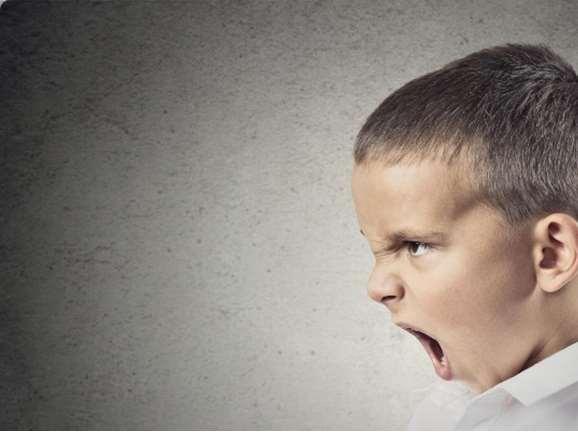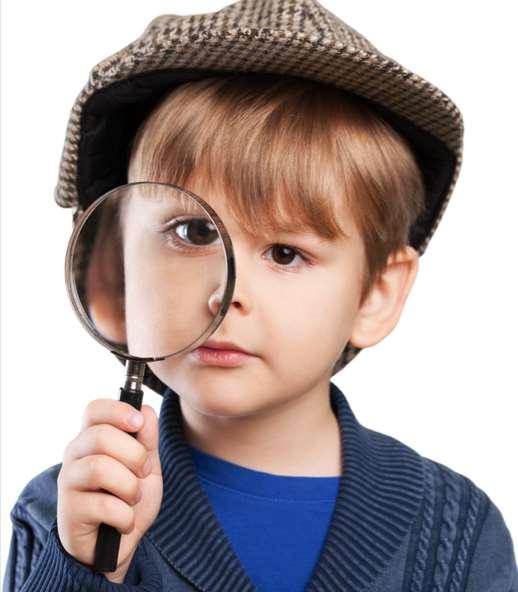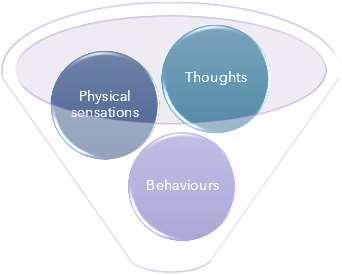Workshop #1: Proven and Effective Interventions to Enhance Executive Skills in Children & Adolescents | Peg Dawson, Ed.D., NCSP
Workshop #2: Optimizing Self-Regulation and Managing Big Emotions | Caroline Buzanko, Ph.D., R. Psych
Workshop #3: Working with Highly Emotionally Dysregulated Children & Adolescence | Eboni Webb, Psy.D., HSP
2
DAY ONE pg. 2 1 DAY TWO 2 EDUCATORS WORKSHOP SERIES - 2024 pg. 11 DAY THREE pg. 100 23
TABLE OF CONTENTS
Executive Skills Questionnaire
Peg Dawson & Richard Guare
Step I: Read each item below and then rate that item based on the extent to which you agree or disagree with how well it describes you. Use the rating scale below to choose the appropriate score. Then add the three scores in each section. Use the Key on page 2 to determine your executive skill strengths (2-3 highest scores) and weaknesses (2-3 lowest scores).




Item
1. I don’t jump to conclusions
2. I think before I speak.
3. I don’t take action without having all the facts.
4. I have a good memory for facts, dates, and details.
YOUR TOTAL SCORE:
5. I am very good at remembering the things I have committed to do.
6. I seldom need reminders to complete tasks
YOUR TOTAL SCORE:
7. My emotions seldom get in the way when performing on the job.
8. Little things do not affect me emotionally or distract me from the task at hand.
9. I can defer my personal feelings until after a task has been completed
YOUR TOTAL SCORE:
Your score
10. No matter what the task, I believe in getting started as soon as possible.
11. Procrastination is usually not a problem for me.
12. I seldom leave tasks to the last minute
13. I find it easy to stay focused on my work.
YOUR TOTAL SCORE:
14. Once I start an assignment, I work diligently until it’s completed.
15. Even when interrupted, I find it easy to get back and complete the job at hand.
YOUR TOTAL SCORE:
16. When I plan out my day, I identify priorities and stick to them
17. When I have a lot to do, I can easily focus on the most important things
18. I typically break big tasks down into subtasks and timelines.
19. I am an organized person.
20. It is natural for me to keep my work area neat and organized.
21. I am good at maintaining systems for organizing my work.
YOUR TOTAL SCORE: YOUR TOTAL SCORE:
1 Strongly disagree Disagree Tend to disagree Neutral 1 2 3 4 Tend to agree Agree Strongly agree 5 6 7
Item




22. At the end of the day, I’ve usually finished what I set out to do.
23. I am good at estimating how long it takes to do something.
24. I am usually on time for appointments and activities.
25. I take unexpected events in stride.
26. I easily adjust to changes in plans and priorities.
27. I consider myself to be flexible and adaptive to change.
28. I routinely evaluate my performance and devise methods for personal improvement.
YOUR TOTAL SCORE:
YOUR TOTAL SCORE:
29. I am able to step back from a situation in order to make objective decisions.
30. I “read” situations well and can adjust my behavior based on the reactions of others.
YOUR TOTAL SCORE:
Your score
31. I think of myself as being driven to meet my goals.
32. I easily give up immediate pleasures to work on long-term goals.
33. I believe in setting and achieving high levels of performance.
YOUR TOTAL SCORE:
34. I enjoy working in a highly demanding, fast-paced environment.
35. A certain amount of pressure helps me to perform at my best.
36. Jobs that include a fair degree of unpredictability appeal to me.
YOUR TOTAL SCORE:
2
Items Executive Skill Items Executive Skill 1 - 3 Response Inhibition 4 - 6 Working Memory 7 - 9 Emotional Control 10 - 12 Task Initiation 13 - 15 Sustained Attention 16 - 18 Planning/Prioritization 19 - 21 Organization 22 - 24 Time Management 25 - 27 Flexibility 28 - 30 Metacognition 31 - 33 Goal-Directed Persistence 34-36 Stress tolerance Strongest Skills Weakest Skills Strongly disagree Disagree Tend to disagree Neutral 1 2 3 4 Tend to agree Agree Strongly agree 5 6 7
KEY
• Response Inhibition: The capacity to think before you act – this ability to resist the urge to say or do something allows us the time to evaluate a situation and how our behavior might impact it. In the young child, waiting for a short period without being disruptive is an example of response inhibition while in the adolescent it would be demonstrated by accepting a referee’s call without an argument.
• Working Memory: The ability to hold information in memory while performing complex tasks. It incorporates the ability to draw on past learning or experience to apply to the situation at hand or to project into the future. A young child, for example can hold in mind and follow 1-2 step directions while the middle school child can remember the expectations of multiple teachers.
• Emotional Control: The ability to manage emotions in order to achieve goals, complete tasks, or control and direct behavior. A young child with this skill is able to recover from a disappointment in a short time. A teenager is able to manage the anxiety of a game or test and still perform.
• Flexibility: The ability to revise plans in the face of obstacles, setbacks, new information or mistakes. It relates to an adaptability to changing conditions. A young child can adjust to a change in plans without major distress. A high school student can accept an alternative such as a different job when the first choice is not available.
• Sustained Attention: The capacity to maintain attention to a situation or task in spite of distractibility, fatigue, or boredom. Completing a 5-minute chore with occasional supervision is an example of sustained attention in the younger child. The teenager is able to attend to homework, with short breaks, for one to two hours.
• Task Initiation: The ability to begin projects without undue procrastination, in an efficient or timely fashion. A young child is able to start a chore or assignment right after instructions are given. A high school student does not wait until the last minute to begin a project.
• Planning/Prioritization: The ability to create a roadmap to reach a goal or to complete a task. It also involves being able to make decisions about what’s important to focus on and what’s not important. A young child, with coaching, can think of options to settle a peer conflict. A teenager can formulate a plan to get a job.
• Organization: The ability to create and maintain systems to keep track of information or materials. A young child can, with a reminder, put toys in a designated place. An adolescent can organize and locate sports equipment.
• Time Management: The capacity to estimate how much time one has, how to allocate it, and how to stay within time limits and deadlines. It also involves a sense that time is important. A young child can complete a short job within a time limit set by an adult. A high school student can establish a schedule to meet task deadlines.
• Goal-directed persistence: The capacity to have a goal, follow through to the completion of the goal, and not be put off by or distracted by competing interests. A first grader can complete a job in order to get to recess. A teenager can earn and save money over time to buy something of importance.
• Metacognition: The ability to stand back and take a birds-eye view of oneself in a situation. It is an ability to observe how you problem solve. It also includes self-monitoring and self-evaluative skills (e.g., asking yourself, “How am I doing? or How did I do?”). A young child can change behavior is response to feedback from an adult. A teenager can monitor and critique her performance and improve it by observing others who are more skilled.
• Stress Tolerance: the ability to thrive in stressful situations and to cope with uncertainty, change, and performance demands. We generally reserve our discussion of this skill to adults, since it seems more relevant with this population. We find it helps people understand the kind of work environment they do best in.
3 Executive Skill Definitions
1. Brings gym clothes on days student has gym class.
2. Homework and worksheets may be placed in any number of notebooks, books, or folders.
3. Sharpens pencil, chats with classmates or takes long bathroom breaks before getting down to work on in-class math assignment.
4. Able to do classroom presentations despite fear of public speaking.
5. Wants to make the 1st string soccer team but can’t bring himself to practice ball handling skills.
6. Figures out the steps to follow to get a summer job.
7. Decides to improve math grade and increases study time for tests and quizzes.
8. Out of seat frequently during independent work time.
9. Takes notes in lecture classes and asks relevant questions.
10. Builds in extra time to complete a given task knowing there could be an interruption.
11. Struggles with creative writing assignment because can’t think of anything to write about.
12. Does work carefully and checks answers before handing in test/assignment.
13. Writes down homework but doesn’t think to check assignment book when gets home.
14. Chronically late for school.
15. Finishes an entire homework assignment before taking a break.
16. Shuts down when criticized by teacher
17. Student places documents in appropriately labeled folders on her computer.
18. Frequently makes faulty assumptions about assignment directions and doesn't check with teacher before starting the assignment.
19. Friend bails on afterschool activity; student adjusts with back-up plan.
20. Says rude or hurtful things to kids.
21. Starts homework without prompting from an adult.
22. Given 4 homework assignments on a given night, can’t figure out what to do first.
4
SKILLS BEHAVIORAL DESCRIPTORS
EXECUTIVE
EXECUTIVE SKILL
RESPONSE INHIBITION
WORKING MEMORY
EMOTIONAL CONTROL
FLEXIBILITY
SUSTAINED ATTENTION
TASK INITIATION
PLANNING/PRIORITIZING
ORGANIZATION
TIME MANAGEMENT
GOAL-DIRECTED PERSISTENCE
METACOGNITION
5
EXAMPLE NEGATIVE
POSITIVE
EXAMPLE
Executive Skill
Possible Strategies
Response Inhibition Post home or classroom rules and review regularly
Arrange for in vivo practice or behavioral rehearsal
Wristband reminder (e.g., to raise hand to talk)
Talking stick (cue to talk)
Sit near teacher
Working Memory
To-do lists (paper, white board to post prominently)
Colored wristbands to remind student of homework assignments
Post-it reminders
Laminated lists (e.g., by door at home or on inside of locker door) to remind kids what they need to take with them
Songs and rhymes as memory aids
Ask student what cues they think work for them (e.g., how they might use smart phone to provide cues)
Prompts in advance about expected behavior
Visual cue on desk to remind them to work quietly
Help student build in technology breaks rather than combining homework with technology use Sticky notes to write something down rather than interrupting
Teach Principle of “off-loading”
Off-loading: This refers to the idea that the brain doesn’t have to work as hard when you can find a way to “offload” some of the tasks we’re asking it to do. Examples: the brain doesn’t have to allot space to remembering homework assignments when we write them down. It doesn’t have to work at remembering something we have to do after school if we build an alarm into our smart phone to remind us…
Emotional Control
Help student write a script to follow
Have a “cooling off” space
Prepare student by asking them to predict what will happen/how they will handle it
Review expectations in advance
Teach students to label emotions
Teach kids: “respond don’t react”
Teach kids to recognize situations or early signs
Teach coping strategy
Rehearse the strategy repeatedly until it is internalized
Teach mindfulness meditation
Self-talk to plan in advance (If/Then: If this happens, then I will….)
6
Strategies for Specific Executive Skills
Executive Skill Possible Strategies
Flexibility
“Normalize” errors
Preview changes in schedule
Praise kids for being flexible
Role play handling situations that require flexibility
Sustained Attention
Task Initiation
Planning
Reduce distractions (seating arrangements, white noise)
Modify/limit task length or demand (end in sight)
Build in variety/choice
Help student choose best time of day to work on effortful tasks
Use fidget toys such as stress balls
Movement breaks
Wiggle cushions/study carrels; dead headphones; listen to iPod; quiet desk/noisy desk/standing desk; “theraband” on front two legs of chair to allow movement
Establish set time to do non-preferred tasks
Teach 1-2-3-Start strategy (student lists the first 3 things they need to do in a work session and then they do them in order)
Make a list and break into bite-sized chunks
Use alarm on smart phone to remind student to start (If they’re not ready to start, have them hit “Snooze” rather than turning the alarm off)
Teach to use a planning template
Help student design a plan/template
Start with big picture; plan backwards
Help student find planning tools that work for them
(calendar, agenda book, apps)
Break task down with a visual (e.g., dividing reading assignment into pages per day)
Put each step of a project on a separate index card or post-it and rearrange to create the right sequence
Use language to showcase flexibility
(stuck/unstuck; big deal/little deal; Plan B)
Do It Later folder (for kids who have trouble leaving a task undone)
Time Timer (make time visible)
Sand timer (real or app)
Identify distractors and figure out how to remove or work around them
Have the child identify something to look forward to doing after work is done
Teach to track time on task using index card or sticky note
Have students set goals (how long can you go before you need a break?)
Help student make a plan for doing the task and include the start time
Practice getting started in isolation start with a short, easy task and just practice starting it at the planned start time
Help student figure out what’s preventing them from getting started and design an appropriate strategy (see Form in Task Initiation folder in Dropbox)
Make a road map
Help student select a graphic organizer that meets the need
Walk through the planning process (use a template)
Have them plan a simple task and gradually prompt to do more of the planning themselves
Ask questions to get student to prioritize (What do you need? What should you do first?)
7
Executive Skill
Time Management
Goal-Directed Persistence
Create a color-coded chart showing student their weekly schedule and where the discretionary time is (school; sports or extracurricular activities; travel to and from school; chores or family obligations; study time)
Practice estimating how long it takes to do something.
Make sure the goal or benchmark is in sight—post it visually (e.g., a picture of the reward they’re working for)
Help them set “Personal Best” goals (i.e., incremental improvement) and teach them about Outcome Goals (“Last week I got a 75 on my math quiz. This week I’ll shoot for a 78.”) and Process Goals (“Last week I studied 20 minutes for my math quiz. This week I’ll study for 30 minutes.”) Talk about the advantage of focusing on Process Goals.
Strategies
Write each task on a post-it and place it on a large dry erase calendar so that it can be moved as needed.
Use a dry erase board for planning with columns for Task, This Month, This Week, Today, Done. Have student move post-its from left to right.
For students who are resistant to goal setting:
Define a goal as something that people want to get better at or to change.
Start with helping them set a goal for something they want to do outside of school.
Skip the word “goal” and talk with them about making a plan (starting with one thing they want to do before the next coaching session)
Metacognition
Help student create sample to match or error monitoring checklist
Embed metacognitive questions into instruction/conversations
Help student decide on how performance will be evaluated
Have the student evaluate their own performance Model thinking aloud to solve problems
Use different strategies—ask kids to evaluate which worked best Use Problem Solving Template
Teach students to ask questions
o What’s my problem?
o What’s my plan?
o Am I following I my plan?
o How did I do?
8
Possible
Optimizing Self-Regulation &Managing BigEmotions
Dr.CarolineBuzanko,R.Psych. caroline@korupsychology.ca drcarolinebuzanko.com



Self-regulationisImportantfor:



UnderstandingSelf-regulation Affects:





drcarolinebuzanko.com
LEARNINGPOSITIVESOCIAL INTERACTIONS LONG-TERMHEALTH ANDWELL-BEING OVERALLSUCCESS INALLDOMAINS
ATTENTIONBEHAVIOURSSOCIAL INTERACTIONS PERSISTENCEMOOD
Self-RegulationFoundationalforOverallSuccess

•Adaptivefunctioning
•Learning
•Emotionregulation
•Communication
•Socialfunctioning
•Long-termhealthandwell-being
•Vocationalsuccess
•Managingselfwithoutothers
Independence

UnderstandingSelf-Regulation
Theabilitytoprocessandmanage thoughts,feelings,impulses,and behaviours.
Self-Regulation:ManagingSelftoAttainaGoal


Anyaction studentsdirect themselvesto


Createchange intheir behaviour

Changethe likelihoodof future consequence/ attaingoal
drcarolinebuzanko.com
Toadjust, weneedto beaware of:

•Changesinourenvironment
•Howwearefeeling
•Howwearebehaving
•Howtorespondadaptivelywhenupset
•Howtobeflexibleandadapttoasituation
•Howtoresistanemotionaloutburst

Self-regulation

Rangeofskillsthat helpstudentsto adapttoasituation ormeetacertaingoal (flexibilitykey!)



BehaviourSensoryProcessingEmotiondevelopment

Self-regulationBuildingBlocks Executive functions


Attention Planningand sequencing

Receptive languageSocialskillsWorking memory


drcarolinebuzanko.com
Self-RegulationInterconnectedDomains
Biological Physiological responseto stimuli. Largely automatic,but canbe influencedby factorssuchas hunger,fatigue, andillness.

Emotion Affective responsessuch asanxiety, sadness,or frustration.

Cognitive Focus, planning,and problemsolvingabilities.

Social Social interactionand understanding thesubtleties ofhuman relationships.

Prosocial Empathy, kindness,and connectionwith others.


Emergesat2months

2monthsRudimentaryselfsoothing

Awareofexpectations

By18months



Self-regulationStarts Early&Develops OverTimeinto Adulthood

Changebehaviourwith direction–adultsstill nearby
2yearsFollowestablishedrules evenwithnoadults
3years



Self-regulation
Acthowtheythink otherswouldwantthem to



Isvoluntaryand effortful/intentional response
drcarolinebuzanko.com
Effortful

Rememberrules+anticipate consequences…
…tomanagethoughtsand emotions…
…toguidebehaviourandmake positivechoicesaboutwhattodo next
Prerequisites!

Internalself-talktoguide behaviour

Thinkbeforeacting, rememberrulesand considerconsequences

Lookbackwardor forward Mentallymanipulate/visualize events Imitatecomplexbehaviours
Effortfulcoping
Useinternalresourcestomanage effectively
Managingenergylevels

drcarolinebuzanko.com

Self-regulationDifficulties
•LowCONFIDENCEtoregulateemotions
•Limitedknowledgeandclarityabout emotions
•Poorgoal-directedbehaviourwhenupset
















drcarolinebuzanko.com
***Stressbecomestoooverwhelming Getdressed Eatbreakfast Benicetoyoursister Packyourbackpack Brushyourteeth Ifyoudon’tgetdone,noiPadafterschool Drainsalreadylimited resourcepool: ToxicEffects EnergyDepletion ExampleStressorsDepletingEnergy Biological Loudnoises,sensory overload Painordiscomfort Inadequateorirregular sleep Lackofphysicalactivity Sittingtoolong Screens Poordiet Dehydration Toohotorcold Allergiesorintolerances Illness Poorairquality–classrooms! Lackofexposuretonatural light Discomfortinclothes GIproblems Overexertion Medicationsideeffects Lackofnaturallight Emotion Changesinroutine, transitions Leavingparents Over-excitement Fearofmakingamistake Trauma Feelingunsupported Negativeself-talk Anxiety,sadness,anger, frustration Guiltorshame Feelingoverwhelmedwith work Inabilitytoexpressemotions Feelingpowerless Uncertainty Loneliness Socialexclusion Pressuretoperform Relationshipconflicts Feelingunlovedor unsupported Stressfromlifechanges Cognitive Putonthespot Uninterestedinatopic Informationoverload Distractions Fastpace,timepressures Lackofclearinstructions Languagebarriers Complexproblemsolving underpressure Memorydemands Clutter Unfamiliarornew environments Inconsistentroutines Lackoffeedbackon performance Concentratingforlong Homework Makingchoices Busyschedule Disorganization Frequenttaskswitching EFchallenges Social Bullying Socialmediapressures Peerpressure Friendshipfires Familyconflicts Socialanxietyorshyness Miscommunications Disagreeingwithwhat someoneissaying Beinginasocialsetting alone Sharingideasaspartofa groupplan Missingfriends Navigatingcomplexsocial hierarchies Troublemakingfriends Culturalassimilation challenges Beingaminority Lackofempathy Managingsocial commitments Navigatingsocietalnorms andrules Prosocial Empathyoverload Moraldilemmas Injusticetoselforothers Feelingundervaluedor unappreciated Observingorlearningabout widespreadsuffering Witnessingdistresswithout beingabletohelp Conflictbetweenpersonal valuesandsocietal expectations Beingundervaluedor unappreciated
Self-regulationDifficulties
•Subjectivereactionstoevents
•Difficultycovertlyemotingandmotivating Difficultywithdelayedgratification
•Difficultywithperseverance
•Sensorysensitivities Daydreaming
•Tiredeasily
•Poorattentionandeasilydistracted Poormotorskills
•Poorsleep
•Pickyeater Hygienetasksdistressing
•Seekmovement/pressure
•Poorsocialcommunication Rigidities
•Immature&socialdifficulties
•Emotionalrollercoaster

Theyneedhelp!
Ifstressistoooverwhelming, studentscan’tself-regulateon theirown. Reserveandreplenishtheir resourcesasmuchaspossible!

ConsiderBrainDifferences!(Makesself-regulationevenharder)
Sensory Processing

•Sensoryoverload
•Unabletomodulateemotionalresponsesto sensorystimuli
•Caninterferewithself-soothingcapacity



•Difficultiesexpressingemotions
•Miscommunication
•Limitedemotionalvocabulary,which Languageimpedesrecognizingandregulatingfeelings


Executive Functioning

•Poorimpulsecontrol
•Poorplanningandorganizationthatcanlead toprocrastinationandlast-minutestress
•Workingmemoryessentialforself-regulation
•Limitedflexibility


drcarolinebuzanko.com
Sensory Accommodations Communication Supports Coachingand Supports
Examples
SensoryProcessing


Language

ExecutiveFunctioning
•Sensory-friendlyenvironment
•Sensorybreaks •Visualschedules(toprepareforsensory-richactivitiesor transitions)
•Sensorytoolsandaccommodations

•Effectivecommunication
•Visualsupportsandcues,prompting •Simplifiedlanguage •Repetitionandclarification •Alternativecommunication(AAC)devices

•Visualorganization •Timemanagementtechniques •Breaktasksdown •EFcoaching •Routinesandpredictability

Can’tlearn
Can’tremember
Brainseekspleasure(stop trying/puttingineffort)
Reactiveresponse (fight/flight/freeze)




Whenstressed, self-regulationis nearimpossible
Intenseemotions
Behaviouraland emotionaloutbursts
Impulsivity
Rigidity
Noself-reflection
Unabletotake perspectives
Disengagement
drcarolinebuzanko.com
•Awareofbehaviourand rules
•Withintheircapacityto actdifferently


Noneofthesecapacities: Behavioursservetoprotect











drcarolinebuzanko.com
Stress School Parents Peerpressures Lackof downtime Social disconnection andloneliness Identityand bodyIssues Multiple pressuresand high expectations Helplessness and hopelessness Socialmedia Localand worldnews
Self-esteem
•Falsemessagestoavoidrejection
•Sohappy!
•Sobeautiful!
•“Likes”worsensself-esteem Otherswon’tlikethe“real”them.



Associal media time Increases Perceived exclusion and social isolation also increases



Massive-Scale Emotionalcontagion
•Webegintoexperiencethe sameemotionsasothers withoutourawareness
•Long-lastingmoods(e.g., depression)canbetransferred throughsocialnetworks

drcarolinebuzanko.com
FOMO

Mostimportantrelationshipfor bondingandoverall development
Discovering: •Self •Values •Personality •WorldFamilyConnection

Nolonger turningto parentsto debriefday andhurts
Screensarereplacing parentsanddisrupting familydevelopment
Technostress
•Hardtodetach= chronicstress

•Shame&stigmaIfnot connected 33

drcarolinebuzanko.com
Bullying doesn’t happen privately anymore
Sendingunsolicitedand/orthreateninge-mail.
Encouragingotherstosende-mailortooverwhelmthevictim
Posting/spreadingrumours.
Makingdefamatorycommentsonline

Sendingnegativemessages
Sexualremarks
Postingthevictim’spersonalinformation
Hatespeech
Impersonatingthevictimonline
Harassingthevictim
Leavingabusivemessagesonline,includingsocialmediasites
Sendingthevictimpornographyorothergraphicmaterial thatisknowinglyoffensive
Creatingonlinecontentthatdepictsthevictiminnegative
Immigrantsvs. DigitalNatives











drcarolinebuzanko.com
ways Trolling Cyberstalking Hateraids 34
Noissuebigenoughtoriskbeing disconnected 35 Screen time Loneliness Depression Withdrawal Anxiety Suicidal ideation Suicidal planning Disordered eating Self-esteem PoorSchool performance
Digital

factors influenceour abilitytocope





drcarolinebuzanko.com
Child •Coping&Self-regulation •Self-confidence •SocialSkills Family •Parenting •Relationships •Connections Community •Connectionswithpeers •Educationalsettings •Healthyrisk-takingopportunities Society •Policies •Values •Legislation Mass media School Social values Culturalnorms&values Peers Infra-structuresCommunity Cohesion Attachment Services Neighbourhood Publicpolicies ChildSibling Communication Models Tech SES Factors
ourabilitytocope RegulationCaregiver Co-Regulation Caregiver Co-Regulation Caregiver Co-RegulationCaregiverCo-RegulationCo-Regulation Infant/ToddlerPreschoolChildhoodAdolescenceYoungAdult Ifnotfilled,affectsemotional, cognitive,andbehaviouraloutcomes OptimalFunctioningthroughCo-regulation Effectiveadultroletohelpkidsunderstandandadjusttheirthoughts, feelings,andbehaviours.Helpmaintainbalance.
Numerous
Numerousfactorsinfluence
Self-regulation
Pyramid
Individualfactors
Opportunities

Supportive environment

Socialconnection

Supportiveadult relationship




GREATESTSUCCESS: CHANGETHEWORLD (Multiplesystems)
Connection
•Fundamentalpriority
•Physiologicallyconstantlyseeking connection
•Criticalforself-regulation

drcarolinebuzanko.com
Optimize Self-Regulation ThroughRelationship
Down-regulate“negative” emotions
•Being
•Tolerating
•Validating




•Avoidpassing ownstresson tokids!!! Adult self-regulation

AdultEmotion-RelatedBehaviours

Safeenvironment Supports Validates


drcarolinebuzanko.com
regulation
dysregulation Adaptive child emotion outcomes Child emotion dysregulation
Perspectivetaking Ownemotion
Criticizing Minimizing Punishing Ownemotion
Stressis Contagious

•Whatisgoingonforme?
•AmIbeingpatient?Warm? Responsive?
•CO-REGULATIONcritical!!!
Needto manageour ownstress, perceptions &responses tobuild relationship andprovide: Choice Context Connection


Choice
•Nocontrol=fight/flight
•Choiceisempowering&stimulatesinnersecurityandwisdom (Showtrustintheirownexpertiseandinternalresources)
Offerchoicesininteractions
Lotsofopportunitiestoestablishcontrol
Choicethroughelicitingtheirinnerwisdom
Getmeta!
Getmindful(noticingnow)&followthat
drcarolinebuzanko.com
ContextBuildsSafety
Nervoussystemalwaysonalert
•Arewesafe?
•Isitsafetoengage?
•DoIneedtorunaway?Orshutdown?

Reframe
Thoughtsaboutthechildand theirbehaviours

AbilitytoSelf-Regulateis RelatedtoIdentity

•Identityandself-concept areco-created!
•Self-evaluationisbasedon theirexperiencesand others’appraisals
•Whataretheconsistent, repeatedcuestheyreceive overtime?
drcarolinebuzanko.com
Consider feedbackloops





Nosuchthingas badkids.


behaviours?
drcarolinebuzanko.com Fail&Avoid Fail&Avoid Fail&AvoidFail&Avoid Fail&Avoid
Whatare
Manifestationsof whatishappeningin theirnervoussystem 54
EmotionsLeadtoBehaviouralResponses












FunctionofEmotions








Behaviours often adaptive forthem

•Togetlove,aneedmet, orsupport…because theydon’tknowhowto getitanyotherway
•Toprotectthemselves fromperceivedlackof safety(emotionalor physical)
drcarolinebuzanko.com
Assert, Angerdefend ShameAvoid Fight, Flee, freeze Fear Support, withdrawal Sadness Connect, Joyengage Attend, explore Excitement
56 Anger Disappointed Sad Hurt WorriedEmbarrassed Guilty Lonely

GreatestpredictorofODD: Adultstress+negative perceptionsofthechild
Remember!


•Strongemotionslimitflexibilityand perspectivetaking
•Emotionsguidebehavioursthatseem mosthelpfulinthemoment
•Tohitthepeerwhobumpedinto them
•Toavoidsomethingthatcouldmake usvulnerable
Perceive Students forTheir FULL Potential

drcarolinebuzanko.com










Ourjobistocreateasenseofbelongingandconnection. Thisisthebasisofeverystrategyweuseinanycontext. Theonlyrealbehaviour

drcarolinebuzanko.com Success Success SuccessSuccess Success LotsofRejectionintheWorld
managementyouneed…. StrongRelationship
RelationshipMajorProtectorFactor

Positivephysicalandmentalhealth
Motivation
Academicoutcomes
Academicself-efficacy
Reducesriskoutcomes

•Violentbehaviour,Schoolfailure,Substanceabuse, Depressionandothermentalhealthchallenges, Suicidalideation,Unwantedpregnancy
Majorpredictoroflong-termhappiness

TeacherRelationship
•Promotesemotionalwell-being
•Reducesproblembehaviours
•Improvesschoollikingandengagement
•Providesasenseofbelonging

•Criticaldifferenceinoutcomesfor kidswithbehaviourdifficulties
•Greatlysupportsself-regulation
•Greatestpredictoroflong-term happiness
drcarolinebuzanko.com
Safe,nurturingrelationships…









Relationship: Howdoyoushowup?





Onesmallchangeinyourinteractionscanbeagamechanger.
Youhavelessthan 6minutes
•Studentsneedtofeelliked andrespected
•WhatcanyouDOto strengthenyour relationshipwithyour studentseveryday?

drcarolinebuzanko.com Multipleadultsathome,school,andcommunitypartoftheirfanclub
Mr.A Mrs.B Coach Tim Mom Math Ms.W Uncle Chris Writing Mrs.D Mr.K
Bullied
69
•Standjustinsideoroutsidethe doororgoaroundtheroom
•Greeteachstudentbyname
•Haveashortpositiveinteraction
•Followstudent’slead Handshake,fistbump,highfive, pinkieshake
•Directthemtothefirstactivity








Emotion Coach

drcarolinebuzanko.com GreetEveryDay!
WhatIneedfromyou
Always remember

•Focusonconnection
•Connectbeforecorrect!
Connection:Staypresent
Bigemotionsdisruptstheirabilityto staypresentandconnected
•Wemustcreatethespacetodothis
•Ourpresencealoneisoftenbetter thanwords


Givespaceforregulation
drcarolinebuzanko.com
Whatdoyouneed fromotherswhen dysregulated?
Weallneeddifferentthingswhen we’redistressed




Evenifthey challenge,we stillhaveto workhard




drcarolinebuzanko.com
Nomatterwhat,theyMUSTbelieve: Weareonyourside!
RESPECTFULPOSITIVEASSERTIVE NONAGGRESSIVE CARING
OpenSupportiveCommunication=Connection







Feelheard Feelseen Feelvalued

Positiveenergyin therelationship

Mythoughtsand feelingsare worthwhile Trust Accepted/ Nonjudgmental
ConnectiontoAction

Listening Demonstrating understanding Valuingtheir perspective& what’simportant tothem



Responding consistently Demonstrating warmthand positiveregard MeetTHEIRneeds

EffectiveCommunication
drcarolinebuzanko.com
Adultsdon’ttendto understandchildren’s experiencesand needs.

Ourbestintentionscanworkagainstus
Weminimizeornegatetheirfeelings
Weexcuseawaytheirfeelings
Kidsmaybelievewedon’twanttohear howtheyfeel
Wemightsendthemessageweknow best
Thebenefitfromourhindsightislost
Wedisruptourconnectionwithkidswhen weshareadviceoropinions


drcarolinebuzanko.com
Effective Communication: Becomea Master Listener •Talklesslistenmore
Effective CommunicationDisarm


Keyto Success: Validation!

Validation Helps Disarm
Theyneedtofeelheardwithout judgmentorcriticism!
•Acknowledgethetruthoftheirexperience
•Recognizeandaccepttheirthoughtsand feelings(eveniftheydon’tmakesenseor seemabsurd!)
drcarolinebuzanko.com
Validation


Fullattention/nodistraction
Staycalm Show Interest
Leanin&nonverbals


Paraphrase
Clarify
Ensureyouunderstandtheir perspective Reflect content


Behesitant!
Acknowledgenonverbals
Beprepared!
Effective Communication WhattoAvoid!

Ensureyouunderstandhowtheyfeel Reflect feelings

Validate the situation
Makessense,giventhissituation Nowonderyoufeelthisway!


LetmeseeifIgotthat.Yousaid…

DidIgetit?


Istheremore?


Thatmakessense…



•Talkingtoomuch
•Emotionalescalation
•Nagging,lecturing,fixing,yeahbutting
•Powerstruggles
•Jumpinginwithouragenda
•Takingthingspersonally
•Negativity
•Judgment
•Becomingdysregulatedourselves
drcarolinebuzanko.com
90

EffectiveCommunication
Activelylisten
Acknowledgetheirfeelings
Acknowledgetheirperspective
Respectfulandcaringattitude
Respecttheirautonomy
Ensuretheyfeelheard
Self-regulateownemotions

UnhelpfulCommunication
Ignoretheirfeelings
Ignoretheirperspective
Disrespectfulanduncaringattitude
Talktoomuch
Emotionalescalation
Lecture,teach,orfixthesituation
Nagging,yeahbutting
Powerstruggles
Jumpinwithouragenda
Negative Judgment
Dysregulatedourselves



drcarolinebuzanko.com
Howwetalkis important Replace negativity with curiosity
Effectivelyexpressing thoughts,feelings,and needs

Verbalangernotdirected toanyone

Verbalaggressiontowards others

Physicalaggression towardsobjects

Physicalaggression towardsothers



Whenwehavea strongrelationship &knowhowto respond effectively
WECAN CO-REGULATE
Self-regulationlookslike:
EarlyChildhood(2-5)
•Briefattention.
•Userulesandstrategiestoguidebehaviour.
•Delaygratificationforlonger.
•Perspectivetakingandempathy.
•Languagebeginstocontrolemotional responses.
drcarolinebuzanko.com
Helpfulto remember!
Early Childhood Co-regulation Considerations
Adultrelationship
•Keyforeffectiveemotionregulation
Teach

•Expressingemotions&problemsolvingthrough directinstruction,modelling,andcoaching
Identify&Label
•Observedemotions
Model
•Appropriateemotionmanagement(e.g.,self-talk)
Prompt&reinforce
•Tofollowthesameprocess.
•Self-regulationsupportedthroughexternal consequences.

RoleofLanguage
Receptiveandexpressiveskillsrelatedtoexecutivefunctions&impulsecontrol
•Parentverbalskillsalsopredictiveofimpulsecontrol
Languagealsoimportantinlearningstrategiesforself-regulation
•Explainrulesandtalkthroughproblems
•Learnrationaleforbehaviours
•Interpersonalcommunication

•Negotiateadultdemandsandpeerconflict
•Verbalself-instructiontointernalspeechandlaterthoughts
•Labelemotionshelpsappraisetheirexperienceandhowtoreact

EarlyChildhood Co-regulationtoSelf-regulation
•Guidedchoicestopromoteasenseofcontrol
•Establishconsistentdailyroutinestoprovide asenseofsecurityandpredictability.
•Usestoriesorplaytodiscussfeelingsand appropriateresponsestodifferentsituations.
•Engagechildreninplayactivitiesthatrequire turn-takingandsharingtonaturallyteachselfregulationinasocialcontext
•Encouragethemtosolveminorproblemson theirownwithverbalguidance,fosteringearly decision-makingskills.
drcarolinebuzanko.com
EarlyChildhood
Co-regulationtoSelf-regulation
Ideasforintheclassroom
•Visualandverbalcuestosignal transitionsbetweenactivities,helping childrenprepareforchangesand reducinganxiety.
•Providestructuredchoicesduring activitiestopromoteautonomywhile ensuringthechoicesalignwith educationalgoals.
•Modelappropriatesocialand emotionalresponses.Userole-playto practicetheseskillsinacontrolled setting,providingimmediatefeedback.


Self-regulationlookslike: MiddleChildhood(6-12)
•Notalotofgrowth
•Stillanimportanttimeforskilldevelopment
•Internalspeechtoguidebehaviour
•Reflectingonone’sownthinking(tomodifyasneeded)
•Increasedself-awarenessofbehaviour
•Attention,flexibility,controllingimpulsesandemotions
•Understandandrespondtoothersappropriately.
•Socialproblem-solving
•Self-regulationbecomingmoreindependent
•Co-regulationstillneededtomanagedifficultfeelings,problem-solvesocialsituations, andlearnexecutiveskills
•Morespacetomakedecisionsandself-monitorwithinstructureandconsequences
Middle Childhood
Co-regulation
Considerations

Adultrelationship

Teachproblem-solving.

Modelconflictresolution.

Providetimeandspacetomanageemotions.

Model,prompt,andreinforcedevelopingskills.

Encourageindependenceintaskcompletionwith externalconsequencesasneeded.
drcarolinebuzanko.com


MiddleChildhood Co-regulationtoSelf-regulation
•Explicitteachingofspecificstrategies -Managingemotions,managingtime,monitoring workandbehaviour,focusingattention,andbeing moreindependentthroughtheday.
•Scaffoldingforcomplextasks:step-by-step guidance,graduallyreducingsupportastheir skillsimprove.
•Positivereinforcementfordesired behavioursthatpromoteself-regulation.
•Collaborativelyproblem-solve -Encouragethemtogeneratepotentialsolutions, considerdifferentoptionsandconsequences
MiddleChildhood Co-regulationtoSelf-regulation

Ideasforintheclassroom
•Implementclassroommanagement strategiesthatencourageself-regulation, suchasaplacetoresettheirbatteryora pointsystemforself-monitoringbehaviour.
•Usegroupprojectstoteachcooperative skills,turn-taking,andconflictresolution, requiringchildrentoregulatetheir behaviourinsocialcontexts.
•Teachskillsdirectly
•E.g.,organization-howtokeepatidydeskor useanassignmentnotebook,providing regularcheck-insandsupportasneeded.


Selfregulation lookslike:
Adolescence(13-18+)

•Increasedfocus,selfmonitoring,andtask completion.
•Strategiestomanage distress.
•Reward-seeking.
•Poordecisionsinthe moment.

drcarolinebuzanko.com
Adolescence
Co-regulation
Considerations

Morereactivetostress
•Increaseinrewardsensitivityandsensationseeking
•Strongerthancognitiveregulation
•Lowimpulsecontrol
•Peercontextincreasesriskybehaviours
•Reducedavoidancebehaviour
•Experimentationandnoveltyseeking
=Self-regulationisoutofbalance


Morevulnerabletoanxiety,depression,andrisk behaviours
Adolescence
Co-regulationto Self-regulation
Adolescence
•Relationship
•Effectivecommunication-alwayssupportiveso theyfeelsafetoexpressandmanagetheir emotion
•Invitationsandseedsofguidanceoncoping mechanisms.
•Coach
•EFskills&healthystressmanagement
•Collaborativelyproblemsolve
•Encouragedecision-makingwhenregulated
•Setandreviewgoals
•Setlimitstoreducereward-seekingbehaviours
•Monitortaskcompletion

Adolescence
Co-regulationtoSelf-regulation
•Encourageprojectsthatrequireplanning,research, andexecutionoverlongerperiods.
•Teachandmodeleffectivetimemanagement strategies.
•Workwiththemtosetpersonalgoalsrelatedtoselfregulationandactionablestepstoachievethesegoals.
•Graduallyincreasetheirautonomyoverdailychoices andresponsibilities,providingguidanceasneeded whileencouragingindependentproblem-solving.
•Fosteranenvironmentforopendiscussionsabout emotionsandstruggleswithoutjudgment, emphasizingcollaborativesolutions.
•Encourageself-reflectionabouttheirbeliefs,values, andgoalsforidentitydevelopment.
drcarolinebuzanko.com
Adolescence Co-regulationtoSelf-regulation
Ideasforintheclassroom
•Provideopportunitiesforstudentsto assesstheirownworkandsetpersonal learninggoals.
•Offerproject-basedlearning opportunitiesthatrequireindependent research,planning,andexecution,withthe teacheractingasafacilitatorratherthana director.
•Incorporatelessonsonstress management,mindfulness,andcoping strategiestohelpstudentsmanage academicpressuresandpersonal challenges.


•Relationshipandsafety
•Explicitandconsistentexpectations
•Positivelyreinforcedesired behaviours
Focusoneffortandimprovements
•Mindfulness



TipsforAllAges
•Relationshipandsafety
•Explicitandconsistentexpectations
•Positivelyreinforcedesired behaviours
Focusoneffortandimprovements
•Mindfulness
•Monitoringtheircapacityandcoregulatingasneeded

drcarolinebuzanko.com

Self-RegulationBatteryExample
SignsforBilly’s energylevel
Optimalparticipation
Communicatesneeds
Easilytransitions
Engaging
Smiles
Followsrequestseasily
Followsrules
Self-regulation Plan/supportsforBilly
Self-regulationsupport
•Adultsmonitoringhis energylevels&providing supportasneeded
•First-thenforless preferredactivities
•Regularbreakstodo energyrestoringactivities
Stillneed support!!

SignsforBilly’s energylevel
OKParticipation
Seeks attention/connection
Canchooseandengage intaskswithfrequent check-ins
Respondstostrategies offered
OKwithfollowingrules
Transitionswithsupport
Negotiates-cancometo agreement
Self-regulation Plan/supportsforBilly
Self-regulationsupport
First-then
Visualschedule
Choices
Hands-onactivitiesout andavailabletouse
Socialacknowledgment whenrequested
Frequentbreakswith energyrestoring activities
Regularlymonitoring signsofstress
Needmore support!!

SignsforBilly’s energylevel
Strugglingtoparticipate
Echolalia
Grabs
LessagreeableLittle patience/hardtowait
Impulsive
Saysheis“bored”
Stompsfeet
Movesawayfromgroup
Maynoteatwhen needed/hungry
Self-Initiatingbreaks
1:1supporttodoactivities
1:1supporttotransition
Rigidnegotiations
Anxiety
Self-regulation Plan/supportsforBilly
Co-regulationsupport
First-then
Modifyexpectations
Followinghisleadabout calmingactivities
Physicalactivities
1:1quiettime
Self-regulationsupportsInto routines
Connectbeforedirect
Reducestressorsdraining energy
Energyboostingactivity
drcarolinebuzanko.com
Needalot ofsupport!!

SignsforBilly’s energylevel
Strugglingtoparticipate
Unresponsive
Doesnotfollowingprompts connectedtoroutines
Pinchingself
Runsawayfromgroup
Hyper,giggly,silly,highpitchedsqueal
Arguing
Noncompliant
Rigid
Tryingtogetcontrolofthe situation
Throwingthings
Anxious
Self-regulation Plan/supportsforBilly
Calmingco-regulation support:
Calmtoneofvoice
Listenvs.talk
Focusonconnection
Reducestressorsdraining energy
Acknowledgeemotions
Saythereforsupport
Providelowenergyoptions forexpectations
Cuddles

SignsforBilly’s energylevel
VeryChallenging Behaviours
Physicalaggression
Verbalaggression
Runningaway
Screaming
Hitting
Faceturningred
Crying
Self-regulation Plan/supportsforBilly
Emphasizingcuesofsafety
Positionbodylowerthan his
Minimaltalking
Lethimknowyouarethere withhim/theretohelphim Ifneeded
Givetimeandfollowhis leadforspaceor connection
Keephimsafe





drcarolinebuzanko.com
Pyramid Individualfactors Opportunities Socialconnection Supportiveadult relationship Supportive environment
Self-regulation
Especiallywith Dysregulated Students

•Strugglingstudentsareofteninan environmentthatismismatchedwiththeir interestsandabilities
Whenthingsare goinggood= certainconditions aremetto supporttheir success


Environmentto bringouttheir innerstrengths
Accommodationsagreatwaytostart
Anychangesinthephysicalorsocialenvironment, taskmodifications,andalteringadultinteractionsto supportEFskills.
drcarolinebuzanko.com
•Movementincreasesbloodflow tothebrain.
•Improvesperformance,creativity, attention,andfocus. Nevertakeawayrecess.Givemore!

HelpfulEngaging(interests)
Immediateconsequences
Frequentfeedback
Personallyimportantorrelevant
Early Supervised 1:1
Structured Clearexpectationsandjobs
Closetoneededmaterials
Quiet/lowarousal
Choices
Notso helpful
Boringtasks
Delayedconsequences
Infrequentfeedback
Lowimportancetasks
Lateintheday
Unsupervisedsettings
Groupsituations
Unstructuredactivities
Uncertainty
Needtosearchformaterials
Loud/higharousalenvironments
Excessivemultitaskingrequirements
Overloadedsensorystimuliwithoutarelevanteducationalfocus
Suddenchangesinscheduleorexpectationswithoutpreparation
Overemphasisoncompetitionratherthancooperation
Poorrelationshipswithpeers
Poorrelationshipswithteachers
drcarolinebuzanko.com



Importanttomatchexpectations towhattheycando

Starttheday offright

Self-control,willpower,& motivationdon’twork
Whatismoreimportantare thestudent’scircumstances



drcarolinebuzanko.com

Structurethe environment forsuccess

8ForcesofMotivation








drcarolinebuzanko.com
Gregariousness •Needtobelong Autonomy •Needfor independence Inquisitiveness •Needtoknow Aggression •Needtoassert Power •Needfor control Recognition •Needfor acknowledgement Affiliation •Needtoassociate &belong
Clearandconsistentbased onwhattheCHILDneeds toblossom.
ConsiderTheirLoveLanguages
ConductaPraise Assessment!
•Howdoyoulikereceivingpraise?How doyouhatereceivingpraise?
•Createadevelopmentallyappropriate assessmentformwithamenuoflotsof feasibleoptions
•Praisestudentsbasedontheir preferences Reflectandadjust!


Effective Teaching

Considerbasicdemands putonsomestudents
drcarolinebuzanko.com
NOTICEHOWYOUFEELWITHTHE FOLLOWINGACTIVITIES...


You’reonlylimitedbyyourowncreativity!
PASSTHEBALL–childwithballtossesballtoanotherchildwhois thenextonetoansweraquestionfromtheteacher
TEAMPLAY–Makeanacademicactivityafriendlycompetition
Getthemcurious!
•Curiositypiquesinterestandlearning Ourbrainshungerforinformation Rewardvalueinthebrainforlearning Itchyneedtoknow!
•Intereststartstodepleteintodeprivation aroundthe7min.markformoststudents Evenshorterforkidswithself-regulation challenges. MUSTgetinterestpiquedrightaway.

EffectiveTeaching
•Intentional,explicit,andtransparent
Kidsneedtoknow:
•Whattheyarelearning
•Whyitisimportanttolearnit
•Whatstrategieshelpstrengthen learning/success

drcarolinebuzanko.com
Strengths based EffectiveTeaching

•Incorporatesstudentinterestsand preferences

•Allowsstudentchoice
•Multimodalinstructionanddemonstration ofknowledge
•Studentshelpdesignassessmentcriteria
•Acceleratedcontent
•Passionprojects
•Reallife
•Successhour
•Balancethedaywithopportunitiesforkidstocomplete taskstheycandoalready
Self-regulationPyramid

Opportunities

Supportive
Individualfactors
Opportunities

Socialconnection

Supportiveadult







drcarolinebuzanko.com
relationship
environment
gSUCCESS Success Success SuccessSuccess Success
Focuson getting them TRYINGand experiencin
Exercise!!!
•Strengthensthebrain
•Chemicalscalmbrain duringstress
•Stresschemicals releasedtohelp stressedoutsystem recoverefficiently Promotesattentionand otherkeyskills
Sleep!!!





•Criticalforlearning:gluefor remembering
Needgoodnightsleepbeforeexam
Needgoodsleepafterstudyingfor exam!
•Helpsmanagestress
•Helpseatbetter


drcarolinebuzanko.com
Socialconnection Supportive environment
Individual Factors Opportunities
140
Moresleep=
•Bettergrades&standardizedscores
•Lessdepression
•Increasedattendance
•Lesscarcrashes
•Lessimpulsivity
•Morecontroloveremotions
•Lessaggression
•Fewersymptomsandillnesses
4/18/2024


Important Considerations


DevelopingSelf-Regulation
Continuousdevelopment Affectedby:
•Environmentalexpectations
•Teaching
•Experience

drcarolinebuzanko.com
Hydration! Healthydiet Appropriate leisureactivities Collections Physicalrecreation Creativepursuits Nature

Self-Regulation
Oftenunawaretheyareofftask/engaging inproblematicbehaviours
Thatiswhyexplicitteachingiscritical
Interconnecteddomains








drcarolinebuzanko.com
Physical Cognitive Emotional Social Prosocial Behavioural Cognitive •Attention,executive functions, perspectivetaking, problemsolving, decision-making
•Awareness& understandingof feelings. •Tolerate&manage
Emotional
uncomfortable feelingseffectively.
Cognitive

Plan
Prioritize
Timemanagement
Breaktasksdown
Remembergoal(vs.goingtofriend’shouse)
Knowingwhattodowhen
Knowingwhatstrategiesworkbest
Knowinghowonelearnsbest

Emotion
Managestress
Staycalmtofocus
Managedisappointmentorself-criticism
Affectsattentionandmotivation
UsingtheEmotionalBrain


Emotional brain
•Emotionisastronger motivatorthanreason
•Whenitwins:
•Connectionsstronger
•Dopamineincreased
•Increaseslikelihoodwill winagain
drcarolinebuzanko.com

Howtomanage theexperienceof emotions
Emotion regulation
Emotion Dysregulation
Awareness,understanding,and acceptanceoffeelings
•Modulateemotionalarousal
•Actinexpectedwaysregardlessof emotions
Inabilitytocopewithelevated emotions(positiveornegative)
EmotionRegulation
It’snotaboutavoiding,ignoring,orsupressingemotions
It’saboutbeingawareofthem, acknowledgingthem,co-existing,and respondinginhelpfulways
drcarolinebuzanko.com
151
Coreskills

MindfulemotionawarenessCognitiveflexibility


Increasingawareness andtoleranceof physicalsensations



Identifyingand modifyingproblematic emotionalbehaviours

Curiosityisakey responseto emotional experiences





drcarolinebuzanko.com
Integrationofabove skillsthroughemotion exposuretomaster adaptiveresponses
Becomingan EmotionDetective 155 Emotion Physiological Cognitive Body language Motivational (response)UnderstandEmotion &Whatitdoes…. 156
Howdo emotions showup?



Emotions
(Andtheyonlylast90seconds!)
EmotionalLiteracy
Studentswithstrongexpressiveabilities arebestabletoself-regulate.
•Expressfeelingsadaptively
•Comfortabletalkingaboutfeelings
•Know/figureoutwhattodonext
Emotioncoachingtosupporttheseskills

drcarolinebuzanko.com 157
EmotionalLiteracy
Nameittotameit
•Buildsconfidence
•Helpswithstaying present


Sayingitoutloud givesusmorepower
Toexpose
Tousecopingstrategies
Emotionsare OKand Adaptive! Tellus something aboutreality
Anger
•Alertsustothreatsorinjustices Protectourwell-being
Fear
•Alertsustodanger
•Protectsusfromharm
•Positivereinforcementfordoingthingsthatpromoteourwellbeingandsurvival Joy
Shame
•Promptsself-reflection,processing,andchange
•Maintainssocialharmony
Sadness

•Alertsustoloss,separation,orunmetneedsandallowsusto processtheevent
•Promotespersonalgrowthanddeepersocialconnections
Excitement
•Propelsresilienceandgrowth
•Fosterscuriosity,creativity,learning,andadaptability
drcarolinebuzanko.com
160
161
162
EmotionsHelpUsNavigateSituations
Keepussafeormoveustowardsgoals








Externalize
Youarenotyouremotions (Sneakytrickstertryingto makeyouthinkthereis somethingwrong…)


Externalize Theyarenottheirbehaviour
Thingstowatchfor: Mindrobbers
Braindrainers
FreakingoutFran
MeanJean
ExplosiveBob
WorryWanda
DistractingDan
YellingMcGee
•Whendoesitshowup?
•Howdoesitshowup?
•Whatcanyoudo?
•Whatsupportdoyouneed?
drcarolinebuzanko.com
Eat pooh No Disgust Get eaten No Fear Unable to process loss No sadness Picked on No Anger
165
Getonoffenseandmakeaplan together–you’reonthesame team!

Exposeit
Remindhowemotionsworks
Yep,there’sBob,that’swhatitdoes.
Wow,itisreallyworkinghardto makemefreakouttoday!
Yeah,weknewit’dshowupnow.It doesn’twantmetowritethetest.
Itwantsmetoavoidnewthings.
Itreallyknowshowtotrytostress peopleout.
EmotionsManifest Physically
MUSThavephysicalreactionstoalert ustowhatishappening (Cannotchangereactionswithoutthis understanding)
•Mostpowerful
•Usuallyshowsupfirst
•Triggersemotionalresponsebeforewe evenrealizeit

•Helpsustopreparetoreacttothe situation Ourbraindoesn’tcareif

drcarolinebuzanko.com
166
167
surviveintheimmediatemoment 168
itshazardousornot Ourbrainwillrespondbasedonwhatweneedto



Whenthealarmgoesoff,thebodygetsreadytofightorrun
Evenwhenitisafalsealarm!
Thebrain(andbody)cannottellthedifference.
PhysicalSymptoms areaProblem


Physicalfeelings:
->Canreinforcethereisa problem
->Canbedistressing,which theywilldoanythingtostop
Becomereactive
Misinterpret,whichincreasessensations…


drcarolinebuzanko.com

Dowhatevertheycantogetridofthem…

PhysicalSensationsare SubjecttoDistortion
•Wrongcontext
•Needtolearntocorrectly interpretinteroceptivesignals

drcarolinebuzanko.com
Feelmorebutcan’tinterpret whatthefeelingsmean
172
173 Coreskill MindfulAwarenessofEmotion: Whatitfeelslikeinthebody!
Dizzy
Racing
Tension
Achy
Sore
Hot
Cold
Tingly
Numb
Sharp
Breathless
Shivering
Sweating
Troubleswallowing
Tired





Shivers
Increasedheartrate
Weaklegs
Ringingears
Blurredvision
Muscletension
Shaking
Trembling
Chestpain
Headaches
Burningskin/sweating
Blushing
Changesinbreathing
Stomach-ache/Nausea
Relaxed
drcarolinebuzanko.com …Whatit feelslike… Model, Validate& Normalize Feelings 176 Thatmakessense! Nowonder-your adrenalglands havesentoutall thatyuckystuff. 177
TWOplaces anxiety Strongershowsup.on leftorright?
Identify& describe
Whenwelabelthedifferentpartsof emotionsandourexperiences,we:
•Changeourinterpretationofthem
•Changehowourbodyresponds
•Dampenamygdala’sfalsealarm
•Turnonprefrontalcortex
•Makeadaptivedecisions
•Learnthatwehavecontroloverour responses Iknowwhatyouare&Iknowhowtohandleyou
•Avoidgettingsuckedin–it’sjustapiece ofinformation

NonjudgmentalAwarenessoftheNOWis Foundational
•Mustdevelopmindfulawarenessof emotions
•Otherwise,can’tworkon strengtheningmoreadaptive responses
•Therefore,needLOTSofpracticeand experiences


FocusonPhysical Sensations
•Bewithit
•Observeitvs.thinkaboutit
•Breatheintoit
•Expandit
•Allowittobethere
•Sensationsmightchangebutthey mightnot.Itdoesn’tmatter!

drcarolinebuzanko.com
180
Teach:Physiological awareness
Knowwhatstressvs.calmfeelslike
Pairacuewordwitharelaxedbody


MoodInductionPractice
•Observereactions,whatevercomesupphysiologically,inanobjective andnonjudgmentalway
Thirdpartyreporter
FocusonthePRESENTMOMENT
•Groundingtechniques
•Debriefattheendaboutallthereactionsthathappened,inanobjective andnonjudgmentalway

drcarolinebuzanko.com
182 Teachprocess tokeepcortex working Evenwhentheiramygdala getsfrustratedandwantsto takeoverwiththestress response.

Teach processto keepcortex working





HowEmotionsManifest: Thoughts
•Negativitybias Primesthemto(non-existent)danger Uncertaintymisinterpreted


drcarolinebuzanko.com
Nameit Whereisit inthe body? Howdoes itfeel? Leftor right? What’s next?
185 Thebraincannottellthe differencebetweenwhatit actuallyseesandwhatit imagines &willreactas truth 186
Seeeventsasthreats Becomesingrained
Mindful Awareness& Acceptanceof Thoughts
•Infiniteamountofthoughts (4.617x10^61potentialthoughts= fourhundredsixty-oneduodecillion andsevenhundreddecillion) 187


•Constantstream
•Unawareofmostofthem
Evenwhentheyaffect howwefeel
•Easytogetstuckonone
•Ifsensitive,thebizarre oneswillalwaysstandout
Successatcontrollingobsessions
Effortintryingtocontrolobsessions
Back&forthbattlewhereobsessionstypicallyalways win…
drcarolinebuzanko.com
110
110

Wecan'tcontrolour thoughts–onlyour responsetothem
Beawareandacceptitforwhatitis: Arandomthought
Sitwith,accept,&acknowledgeworries
Focusonraisingawarenesstothoughts




Recognizing them Acknowledging them DisentanglingfromthemAcceptingthem vs.tryingtochangethoughts

Mindfulness
Notaboutrelaxingor gettingridofphysical symptoms

Notaboutchanging thoughts
drcarolinebuzanko.com
190
192
Mindfulness

Mindfulness

Activeprocess Payingattentiontothepresent momentinanon-judgmentalway

Beingdetectives





drcarolinebuzanko.com
193 IT’SABOUTNOTFIGHTINGTHEM
Thoughts ofPastor Future Negatively influences affect, thoughts, behaviours Keeping thinkingof pastor future
EmotionsLikestoKeepusStuck! 195 Atthe expenseof valuable information now
Negatively influences affect, thoughts, behaviours
Mindfulness
Acceptance
•Confrontemotions
•Sitwithemotions
NOTresist,control,oreliminate emotions.
•Needtostayhereandattendtothe currentcontext
Tokeepprefrontalcortexonline
•Toattendtocorrectiveinformation
•Tolearn!
Versusgettingsuckedintoworries, whichintensifiestheemotional experienceandkeepsusstuck
ToAccept,Understand
•Emotionsareanormal partofbeinghuman
•Physicalfeelingsand thoughtsaretemporary
•Thoughtsarenotfact

drcarolinebuzanko.com





















drcarolinebuzanko.com EmotionDialAcceptanceDial 01000100 Defusion •Noticing thoughts vs.getting caughtin thoughts CreateaBingoCardofStrategies Past/Present/FutureDistancing Train,balloons, bubblesclouds,or leavesontheriver Thankthem WaroftheWorldsObjectifyNamethatStoryRepetition HumourParadoxBodyScanLiteralization 201

Didyouknow? Fearandexcitement feelthesameinthebody? BUTHOWWETHINK ABOUTITMAKESALLTHE DIFFERENCEINTHE WORLD….

CoreSkill: CognitiveFlexibility


Ourthoughtsarenot alwaystrustworthy!
drcarolinebuzanko.com
KnowledgeInfluences
SensoryInformation (e.g.,allfacesarealways convex)
•Ourknowledge/experience misleadsusintoseeingthe maskasconvex
Bottom-upsensory informationisoverriddenby top-downknowledge



•Informationfromoursenses areonlylooselyconnectedto whatweexperience
Fragmented
Ambiguous
Lotsofeffort

drcarolinebuzanko.com
205
206 Illusionof
207
Emotions (andallthataccompaniesit)






























drcarolinebuzanko.com ANTS Teacher looksat me Iamin trouble Someone saidalie Ifailed She’s calling home She’s criticizing me Thefirst draft 209 Theseareonlyguesses!! Wrong99%ofthetime CreatingDistancefromThoughts 210 DISMISS RollmyeyesYou’reso boring! BigdealSowhat? DEMANDMORE Isthatallyou got? Isthatthebest youcancome upwith? Don’tyouhave something scarier? Can’tyougive memore?
































Mixinguptheday
Findthreewaystolearnabouta topic
Findthreewaystoshowwhatyou knowaboutatopic
StopandSwitch(e.g.,dribble,switch tomath,backtoballactivity)
drcarolinebuzanko.com Situation Possibility 1 Possibility 2 Possibility 3 Possibility 4 ANTS Teacher looksat me Iamin trouble Gotan Aon mytest She needs my help She’snot looking atme Sheneedsto tellme something important Be Creative!
PracticeFlexibility: GettingUnstuck
•Looksliketheamygdalaistryingtogetyoustuck
•Whatlittlechangecanhelp?
•Howcanyoutrysomethingdifferent?
Brainstormtobuildflexibleproblemsolving.

BuildAwareness! Externalize&GetMeta
•WhendoesStuckStanshowup? Whatiseasytogetstuckon?Whatiseasyaboutit? Whatiseasytoavoidgettingstuck?Whatiseasy aboutit?
Whathelpsyougetunstuck?Whatworkedbefore? Whatdoyousaytoyourselftogetunstuck?
•Identifyobstaclestogettingunstuck
•Collaborativelydevelopstrategiesto overcomethem

drcarolinebuzanko.com
Unexpectedevent/mistakeof theday&howyouhandledit 216
TheImportanceofMistakes
Talkaboutyourownmistakes
Talkaboutothers’experiences


Embrace mistakes
Havea“Mistakeoftheday”to share:
•Amistakeorchallengethey faced
•Howtheyfixed/handledit
•Whattheylearned

drcarolinebuzanko.com
Mistakeoftheday/ HonouraryMistakeWall
Embracingmistakes
Whatwasthisexperiencelike?
Whatdidyoulearntoday?
Whatmistakedidyoumakethattaughtyousomething?
Whatdidyoutryhardattoday?
Whatcanyoulearnfromthis?
Whatwillyoudothenexttimeyouareinthissituation?
Whatadvicecanyoutellothersbasedonthis?


Important!
Itisnotwhat theydidwrong thatcounts,but whattheydo next.
Forgingahead GetUnstuck
Noneedtoaskwhy,lecture,orexplainthe problem:Havethemthinkofhows
Howwilltheygetunstuck
Howwilltheyfixthismistake?
Howwilltheymoveon?
Howwilltheyhandle(thesituation)?

drcarolinebuzanko.com
•Never,always,no matterwhat, nothingcanchange, noonelikesme

All-ornothing

•Goodandnotso good

•Thispartishard
•Iwillfocusonone stepatatime











Scalingquestions
drcarolinebuzanko.com
Allornothing: Ican’tdoanything Ican’twrite Ican brainstorm Icanfollow atemplateIcanedit Comingup withideas onmyown ishard(But Icanwitha storywheel)
easy Math:EasyReading:EasyGym:easy
Breakitup
Somethingsare
Difficultyscale Easy Hard
Whatiseasythatmakesit9(andnot10)?
WhatcanIdotobringthisdownto7or8? 9
WhatcanIalreadydo?
Wanttoscale
WhatcanIdotobringthisupto4?7or8? 3
Whatdoyoulikethatmakesit3(andnot1)?

drcarolinebuzanko.com
Hateit Loveit
Coreskills
Identifyingandmodifyingunhelpful emotion-drivenbehaviours


Whatitlookslike
•Ourbodycommunicateshow wearefeeling
•HowwouldothersknowwhenI amfeelinganxiousbylooking atme?
WhenFreakingoutFranshowsup:
WhatIfeel
Disappointed
Mybodyfeels
Chestpain, headache
DisconnectedNausea
Unloved
Heartburn
HowFFwantsmeto do&interact
Getintheirface,swear, punch,yell,blame
Avoidtalkingabout whatisgoingon, retreat

Sayhurtfulthings,yell, cry,andthrowthings
drcarolinebuzanko.com
230
Important!
MUSTunderstandhow theirbehavioursare maintaining,oreven worsening,their emotionaldiscomfort
Thebehaviouris reinforcedinthe moment,increasingthe likelihoodofusingthis strategyagaininthe future





Remember!Short-andlong-termoutcomesof maladaptivevs.adaptivecopingstrategies

Maladaptive



Adaptive Coping





EmotionalBehaviours
Function: Toreducetheintensityoftheemotion
Goal: Totoleratetheintensityoftheemotion
drcarolinebuzanko.com
232 Emotional Discomfort Behaviour Feelbetter inthe moment Brainis rewarded 233
moment
discomfort
run Ingrains emotional pathways
Coping Feelbetter inthe
Worsens
inthelong
distressin
run Create new healthy pathways
Feel
ginthe moment Tolerate& manage emotions inthelong
234

90%ofwhatkidslearnis fromwhatthey experience
Resilience
Abilitytoadaptwellto adversity,trauma, tragedy,threats,oreven significantsourcesof stress.

Resilientkids
Effectivelyrespondtoand copewitheverydaychallenges -Thisiswherewearegoing!

drcarolinebuzanko.com
235
Whenstudentsavoidormiss outonsituationsthatmake themuncomfortable,theylose thechancetopracticeand grow



Werobthemof important opportunities GetoutofTraps
drcarolinebuzanko.com
differenceintheworld Saying “Don’t worry” doesn’t work 240 Getstuckinconstant needforreassurance Noskillsdeveloped Minimizing
Thisalonecanmakeallthe

Enabling
AccommodationBehaviours

Participation •Assistinchecking behaviours •Assistin avoidance •Reassure

Modification•Preventtriggering situations



drcarolinebuzanko.com
ACCOMMODATIONS
242 243

CreateOpportunities: StressInoculation
•Needstudentstopracticemanaging stressorsandemotionseffectively
•Exposurewithafocusonsuccess–withintolerancewindowatfirst
Outcomes directlyrelates totheir willingnessto feelbig emotions









drcarolinebuzanko.com
245 EmotionDialWillingnessDial 01000100
Coreskills
Integrationofalltheskillsthroughemotionexposure toMASTERADAPTIVERESPONSES


IntegrateSkills throughEmotion Exposure
Integrateskillstomasteradaptiveresponses
•Talkingnotenoughtochangethebrain! Doingmakesstrongermemories
Doinggivesusexperience
Quickerprogress
•ProvokeSTRONGEMOTIONS-MUSTshow upforlearningtohappen
Practicetobuild awarenessofemotions
Notbeingfirstinline Losingagame Meetingacutepuppy iPadunavailable
Someonecheatsatsoccer Makingamistake

drcarolinebuzanko.com
Studentsgetstuckinnegativepatterns whenemotionsshowup
HELPFUL


UNHELPFUL

Avoidrealdanger
Becomesaproblematic learnedbehaviourthat’s hardtobreak
Neverlearn anythingnew
Excessive&incongruentwiththe context
Getsinthewayofwhat’simportantto us
Basedonshort-termgratificationvs. long-termconsequences
Thatthingsweren’taswe expected Thatfeelingspass Thatwecancope
Remember!!!

Ensuretheyseethelong-termconsequences

NooneunderstandsmeRefusetoparticipateSocialisolation



Theyhatemeandalwayscriticize me Swearwhengivenfeedback, throwthings Peoplewillstoptryingto helpme





Ican’tdoanythingright.Ripworkup,runoutofclass &slamdoors Iwillnevergetbetter Ihavetofightbackorthey’llwalk alloverme. ThreatenorbeatupMightbeafriendshipthere




IfI’mincontrol,Ican’tbehurt.Dominateinteractions,no compromise Nofriends



They’regoingtopunishme anyway,sowhybother?Breakrules

Mightnotbeintrouble(just makingitharderformyself)

drcarolinebuzanko.com


DailyPractice! Focusonawareness
•Objectivelyobservewhatevercomesupinthepresentmoment
Physicalsensations
Thoughts
Behaviouralurges

HypothesisTesting
Lotsofexperimentsand experiencesneeded!
•Whatdoyouthinkwillhappen?
•Howsure?(1-10)?
•Wasthehypothesisright?
•Whatdidyoulearn?

drcarolinebuzanko.com Otherwise,youget resistance 253
254
255
Willingness Action Plan




Bigwhy:
ThestepsIneedto takeare: Iwilltakethefirststepon (date)at(time)
ThediscomfortIam willingtohaveto achievethisgoal:
CreateManyOpportunitiestoFocus onEmotions&WorkonitEveryday!
Speakinfrontofa smallgroup

Simulatetest-taking conditionswith practiceexamsor timedquizzes.


Makesmalltalkwith someonenew
Practicelosinga gametosomeone whocheats


Usepictures,videos, orliveencounters withfearedbugs

Role-playscenarios whereexpresstheir concernsorassert themselvesinasafe setting.

Createsituations wheretheycansafely expressangerand practicecoping strategies. Toleratingnot knowingwhat’s happeningtoday.

Engageinactivities they'vebeen avoidingdueto emotionaldiscomfort.


Experienceand toleratephysical sensationslike increasedheartrate throughexercises.

Watchsadvideo Kindierunningaway withthesoccerballin themiddleofagame


drcarolinebuzanko.com
Goal:
Thoughts Feelings Sensations
Urges Icanremindmyselfthat:

Opportunities formanaging theUnknown& Risk-Taking
Capitalizeoncurrentchallenges!
•Challengesarepartoflife&dealing withthemispartoflearning.
•Optimizeteachablemoments Letthemtry. Letthemfail(butdon’tsetthemupforfailure) Workthroughnextstepsandhowtofix things

Createchallenges!
Challengeoftheday,week,or month Workthroughthingsontheirown Mightgetfrustratedinthemomentbutthe intrinsicrewardoncesolvedisfargreater thanifhelped

drcarolinebuzanko.com





https://parentsoftheyear.comhttps://bit.ly/overpoweringemotionspodc ast
CarolineBuzanko,PhD,R.Psych. KoruFamilyPsychology caroline@korupsychology.ca drcarolinebuzanko.com


drcarolinebuzanko.com Hard Working onIt Success!












Working with Highly Emotionally Dysregulated Children & Adolescents






5/1/24 1
May 2024 2
Time Topic
-10:30a Parenting and Attachment
-10:45a Break
-11:45a DBT & the Biosocial Model
-12:45p Lunch
-2:15p Key Childhood & Adolescent Disorders and Interventions
-2:30p Break 2:30p -3:30p Building Resource Toolkits
Eboni Webb, PsyD, HSP
Schedule
8:00a
10:30a
10:45a
11:45a
12:45p
2:15p
Rudyard Kipling
often
the
would ask me why I had never told anyone how I was being treated. Children tell little more than animals, for what comes to them they accept as eternally established.”
“Often and
afterwards,
beloved Aunt

Today’s Objectives
1.

Sit and breathe

• Wait for any sense of discomfort (e.g. restlessness, an itch)
• Note the desire to move and resist it
• Notice thoughts that arise. These thoughts are just thoughts. So gently bring your attention back to your breath and bodily sensations. Note the changing position, shape and quality of the discomfort over time. Be interested in feeling it as precisely as you can. Notice how the shape and intensity changes with the cycle of the breath.
• Is it stronger during the in breath or during the out breath?
5/1/24 2
Understand the biosocial model of pervasive emotional dysregulation disorders found in innately sensitive children. 2. Apply behavior modification strategies at the earliest stage of dysregulation. 3. Recognize the significance of structure in skills training and home environments, and demonstrate methods to teach parents or caregivers to implement these strategies effectively. 4. Adapt each skills module to reflect the language of the child, fostering better communication and understanding.
Define the roles of educators, caregivers, and parents in re-establishing a safe and supportive structure that enables the child to learn and generalize skills effectively.
5.
Steps to Adaptation: learning how to fit in your family system Intention Attunement Communication Action Repair Intersubjectivity (Trevathen, 1980) Mirror Neurons (Gallese, 2007) Wounding Trauma


Attachment goal secure and authoritative parenting produces autonomous and interdependent adults


Attachment Rule
Attachment is not fixed or absolute. Growth and change are driven by one’s season of life.
Definition: Attachment
“An in -born system in the brain that evolves in ways that influence and organize motivational, emotional and memory processes with respect to significant caregiving figures.” (Bowlby)
Affect Regulation
Behavioral Regulation
Cognition Self-Concept
5/1/24 3















5/1/24 4
Secure Base Seeking, monitoring, and attempting to maintain connection to a protective attachment figure. Safe Harbor Fleeing to an attachment figure when in situations of danger or alarm Proximity Maintenance Attunement, presence, accountability, direction, protection, correction, and connection. • Secure Base • Safe Harbor • Proximity Maintenance Parents, Grandparents, Extended relatives, mentors, teachers, leaders Neighborhoods, churches, community centers, schools, service providers (e.g. health, legal, mental health), government Attunement, presence, accountability, direction, protection, correction, and connection. How do we embody this as therapists? Secure Base Attuned therapists that are skilled listeners, attuned, present, and activated towards change and challenge Safe Harbor Office safety and security, informed consent, confidentiality, community safety planning and protection Proximity Maintenance Tolerate, Modulate, and Communicate Difficult Emotions, Feelings, and Sensations as they arise in session.
How do we live and thrive as humans? (Bowlby to Ainsworth)

Understanding Attachment Styles









5/1/24 5
THE STRANGE SITUATION SECURE ATTACHMENT
Reunion behaviors are more insightful than separation behaviors. o Immediate reassurance from the return of their secure base (distress is natural and expected at separation). o Reconnection prompts return to independent exploration and play. o Child Behaviors: Flexibility and resilience
Secure Parent = Sensitivity, attunement, acceptance, cooperation and emotional availability THE STRANGE SITUATION AVOIDANT ATTACHMENT
Reunion behaviors are more insightful than separation behaviors. o Apparent lack of distress should not be mistaken for calm. Superficial indifference is a trauma defense. o Reconnection displays active rejection of bids for connection by parent resulting in limp physical connection. o Parent Behaviors: Withdraw and Rebuff o Avoidant Parent = Inhibited emotionality, aversion to physical contact, and brusqueness
o
o
o















5/1/24 6 THE STRANGE SITUATION AMBIVALENT ATTACHMENT o Reunion behaviors are more insightful than separation behaviors. Looking for their absent parent even when the parent is present. o Two presentations: Angry or Passive o Reconnection displays overt bids for connection and expressions of rejection (e.g. full-blown tantrums, leaning away, etc.) to implicit bids for solace displayed in helplessness and misery. Lack of exploration. Parent Behaviors: Unpredictable and Intermittently available o Ambivalent Parent = Insensitive signaling, neither verbal or physically rejecting while discouraging autonomy Equity vs. Equality Parenting with authoritative and connected strategies Understanding Your Parenting Style




5/1/24 7
Styles Authoritative Authoritarian/Abusing High nurturance, expectations, and control Moderate communication High expectations, and control Low communication and nurturance Democratic Attachment Power Assertive Parentastic.org.
Neglecting Permissive Low nurturance, expectations, control and communication High nurturance, moderate communication, low expectations, and control Uninvolved Indulgent Parentastic.org. PARENTING STYLES Types Defining Feature Nurturance Communication Expectations Control Authoritarian Power- Assertive Low Low High High Abusive Violence Low Low Low High Authoritative Reciprocal High Moderate High High Democratic Attachment Parenting High High High Moderate Neglecting Uninvolved Low Low Low Low Permissive Indulgent High Moderate Low Low http://parentastic.org/parenting/parenting -styles/
Parenting
Parenting Styles


5/1/24 8 PARENT ATTACHMENT
ADOPTION Parent Attachment Style Childhood Attachment Type American Population % % of Low-Risk Adoption % of Troubled Adoptions (e.g. trauma, abuse, illness) Autonomous/Free Secure 15% Dismissing Avoidant 20% 42% Entangled Ambivalent 20% 42% Unresolved Disorganized 1-2% TCU Institute of Child Development (Producer). (n.d.). Attachment Dance [DVD]. Available from TCU. Family Dialectical Dilemmas Limits Presence Excessive Leniency Fostering Dependence Normalizing Problem Behaviors Authoritarian Control Forcing Autonomy Pathologizing Normal Behaviors DBT Theory: The Biosocial Model Understanding the impact of developmental and environmental trauma
STYLE &




Common Types of Invalidation
Abuse and neglect
Being ignored



Open rejection of thoughts, feelings, and behaviors
Making “normal” responses “abnormal”
Failing to communicate how experience “makes sense”
Expecting behaviors that one cannot perform (e.g., due to developmental level, emotionality, or behavioral deficits
5/1/24 9 Five
Mindfulness 25 Overview Children can suffer from emotional vulnerabilities Emotional vulnerabilities can come from many sources (e.g., attachment issues, loss, trauma), but is often assumed to be biological Chronic and consistent invalidation exacerbates emotional vulnerabilities An ongoing, reciprocal relationship exists between emotional vulnerabilities and environments
Movements
• In utero assaults
• Delivery difficulties
• Health of both parents during conception
• Mental Illness
• Abandonment via adoption
• Learning difficulties


•
•
•


Stress & Cortisol



5/1/24 10
Identity disturbances • Racial issues • Inside threats • Sexual assaults
Accidents (falls, vehicle, etc.)
•
Divorce
parents
siblings
• Prolonged separation from
and/or
Frequent moves
School transitions
Bullying (Cyber, physical, etc.)
•
Our Survival Hormone WillI survive this? Whyisthis happening? How do I fix this? What can I learn from Prefrontal Cortex Observing Thinking Decision-Making Mid Brain Emotional Center Memory Lower Brain Survival defenses Automatic processes



Excessive Cortisol Effects
• Neurotoxicity to Hypothalamus
• Neuron Death
• Clogging of the corpus callosum connecting the left and right hemispheres
• Suppression of the immune system
The Powerful Amygdala


Key Features
• Reactionary
• Triggers Sensory System (Smell and Touch are the most direct pathways)
• Controls autonomic responses










5/1/24 11
Safe Danger! Life Threat 33
What Happens During A Stress/Trauma Response?





Acute Response to Threat Study







5/1/24 12
Hyperaroused Continuum Rest (Male Child) Vigilance (crying) Resistance (Freeze) Defiance (posturing) Aggression (hitting, spitting,etc) Dissociative Continuum Rest (Female Child) Avoidance (Crying) Compliance (Freeze) Dissociation (Numbing) Fainting (checking out, mini-psychosis) Primary Brain Areas Neocortex Subcortex Limbic Midbrain Brainstem Cognition Abstract Concrete Emotional Reactive Reflexive Mental State Calm Arousal Alarm Fear Terror
the brains of people who have been abused, the genes responsible for clearing cortisol were 40% less active” (Morse &Wiley, 2012) Acute Response to Threat; (Perry, Pollard, Blakely, Baker & Vigilante, 1995). Adapted from study results for teaching.
Sensorimotor Psychotherapy Institute®/Sensorimotor Psychotherapy founder, “Pat Ogden HYPERAROUSAL HYPOAROUSAL
“In
Window of Tolerance













5/1/24 13 From
The Purpose of Co-Regulation 39
Dysregulation to Self-Soothe

















Teenage Brain

5/1/24 14 Child Dialectical Dilemmas Connected Authoritative Increasing Choices Supervising Validating Stability Keeping their world small Giving Permission Acceptance of Change The
The Adolescent Brain (Adapted from BrainstormbyDanielJ.Siegel,MD) Increase in the development of pleasure and reward centers in the brain Lower baseline of dopamine levels until a new experience occurs which flushes the brain with heightened dopamine • Neural fiber integration Neural pruning Ages 12 -24 Heightened experience of boredom Impulsivity • Hyperrationality Gist thinking • Intense social engagement • Seeking new experiences despite the strangeness of the situation • Enables leaving the nest Risk - taking • Exploration Curiosity Identity

Teenagers Change the World


5/1/24 15
The Little Rock Nine 1957 Stress
Our
Management
Body’s Natural Defense
Hormonal Counter to Cortisol=Oxytocin



5/1/24 16
Responsive • Activated through birth Increases sense of safety and connection Must act in order for it to be released Can accumulate through repeated activities. Problematic Auto-Regulation is Learned SelfSoothe Cortisol Stress Behavior Oxytocin Now Doesn’t This Get Some Oxytocin Flowing?
Hormonal Counter to Cortisol=Oxytocin
Treatment Targets to Increase Oxytocin Without Problem Behaviors

• Hugs
• Sing in a choir
• Give a back rub/foot rub
• Hold a baby
• Stroke a dog or cat
• Perform a generous act
• Pray
• Make positive eye contact
• Breath work
• Listen without judgment
• Positive touch
• Proximity
• Laugh/Dance
The

Carl Rogers

5/1/24 17
“
curious paradox is that when I accept myself just as
am, then
can
I
I
change.
Attachment Style: Adolescent (Chara, 2005) Characteristics Secure Avoidant-Insecure Ambivalent Resistant Insecure Disorganized Insecure Predominant Emotions Optimism; mature emotionality Detachment; callousness Anxiety, anger Fear, doubt Ability to Trust Desires trust; finds it easy to trust Indifferent toward trust mistrustful of others Desires trust; but mistrustful of others Desires, but wary of, trust, suspicious of others Ability to be Intimate (mutual self-disclosure) Desires intimacy; able to be intimate Avoids intimacy; difficulty being genuinely intimate Desires intimacy, but doubtful intimacy is sincere; difficulty being intimate Intimacy desires mixed with fear and doubt; difficulty being intimate Fear of Abandonment Low; finds security in relationships Low; indifference born of self-reliance High; fears being rejected High; strong fears of rejection
















5/1/24 18 Adolescent DBT Dialectical Dilemmas Empathic Relational Skill Enhancement Trust Privacy Self Acceptance Suspicion Transparency Secure (60%) Anxious/Preoccupied (20%) Avoidant/Dismissive (20%) Disorganized (varies) Child Experiences and Behaviors Feels “safe, soothed, seen, and secure” Child will be flexible, curious, and connected. Able to participate in relational ruptures and maintain a sense of connection even in disagreements Feels “confused and frustrated.” Child might be clingy, desperate and anxious. Feels that parent is an “emotional desert” Learns to get needs met by acting like they don't have needs. Becomes disconnected from emotions and presents with developmentally inappropriate selfreliance. Feels frightened or terrified by their parent, experiencing fear without solution or resolution. Feels that their parents are unsafe despite the urge to seek security from them. Unpredictable and erratic behaviors marked with emotional turmoil. Caretaker Behaviors Creates a compassionate environment, able to regulate their own emotions and behaviors. Sees child as a separate person. Moderately attuned (30%) to child’s needs. Able to empathize and stay present with the child. Able to repair ruptures. Intermittently available or rewarding and then will shift to being unavailable and misattuned Might unintentionally look to their child to meet their emotional needs. Turns to child to feel good about self. Provides basic and instrumental needs for the child but will have trouble responding to the child on an emotional level. Engages in terrifying behaviors and unable to meet their child’s emotional, psychological, and relational needs. Not attuned to others Adult Attachment Style (Working model of relationships based upon childhood) Can trust others to be there for them as needed. Able to maintain their own unique identity while remaining connected to others. More satisfied in relationships. Marked with honesty, openness, and equal, and interdependent. Has difficulty trusting others will there for them when needed. Maintains clingy and insecure behaviors. Seeks rescue versus establishing a real loving and trusting relationship. Frequently will test and sabotage relationships. Struggles with intimacy and has a hard time being vulnerable or showing any dependence on others. Often wards off partners attempts to be close, experiencing them as “needy.” May have difficulty remembering much from their childhood, and they may see early experience as having no impact on who they are as an adult. Tendency to lead more inward lives, turning off their Learns that relationships are dangerous and will hurt you, but they desperately need others. They may be desperate or clingy when someone pulls away then aloof and withdrawn when someone comes toward them. Their behavior is often erratic and scary for their partners. What Does Earned Security Look Like?
The Biosocial Model
Emotional vulnerabilities are characterized by:
sensitivity
Emotional reactivity
- Slow return to emotional baseline
Over time emotions get sensitized, leading to a kindling” effect
This emotionality (and associated invalidation) is associated with many problems (disorders)
Emotionality leads to escape and avoidance that leads to chronicity






5/1/24 19 Loving Well SECURE BASE SAFE HARBOR HOLISTIC INTERVENTIONS PROXIMITY MAINTENANCE Mind Body Safe Space School Safe Consistent Care Providers Flexibility Attunement Limits, Rules Counselors Home
- Emotional
-
Time Emotional Arousal Innate Sensitivity Coping-Avoidance Escape Behaviors Heightened Reactivity
Biosocial Theory Coherently Guides Treatment Targets and Strategies
Validation is a primary intervention to:
Reduce acute emotionality
Provide gentle exposure to emotions
Provide a corrective validating environment (and new learning)
Create a bridge to learning self-validation
Open the client up to change interventions
Emotion regulation is taught to:
Understand how emotion happen
Reduce vulnerability to intense emotions
Increase opportunities for positive emotions
Assist in stepping out of ineffective mood-congruent behaviors

Biosocial Theory Coherently Guides Treatment Targets and Strategies
Mindfulness (non -judgment and acceptance) is taught to:
Reduce amplifying emotions
Reduce escape and avoidance of emotions
Create qualitatively different and effective experience of emotions
Distress Tolerance is taught to:
- Provide healthy ways of coping with emotions when needed
Use the theory to conceptualize the purpose of the interventions used

What to Look For
5/1/24 20
-
-
-
-
•
• Perfectionism
Anger,
Others • Fragility,
Emotional Vulnerability • Active avoidance • Passive avoidance, dissociation Inhibited Experiencing
• Self-hate/criticism
People-pleasing
SelfInvalidation •
Bitterness Towards
Vulnerability
How to Help
Self-Invalidation
• Modeling failure
• Communicating validation Emotional Vulnerability
• Model self-care
• Create a safe home environment Inhibited Experiencing
• Model Emotions
• Display authentic reactions without exaggeration
Unrelenting Crises
What to Look For
• Uncontrollable Events
• Crisis -Generating Behavior
• Helplessness Active Passivity
• Willfulness, Demandingness
Apparent Competence
• Disconnect between verbal and non -verbal behavior
• Contextual Competence (mood/situational)
How to Help
Unrelenting Crises
• Control the Controllable in the Home
• Practice/Model Delayed Gratification Active Passivity
• Cheerlead
• Encourage problemsolving
• Set Personal Limits Apparent Competence
• Highlight effective behaviors observed
• Lose the assumption of how the loved one “should” behave in all contexts based upon one.
5/1/24 21

Key Childhood to Adolescent Disorders
5/1/24 22
STATISTICAL
Disorder Prevalence With Severe Impairment or Distress Median Age of Onset Anxiety 31.9% 8.3% 6 years of age Behavior 19.1% 9.6% 11 years of age Mood 14.3% 11.2% 13 years of age Substance Use 11.4% Not analyzed 15 years of age Dual Diagnosis 40% Not analyzed Not analyzed Merikangas, K.R., He, J-P, Burstein, M., Swanson, S.A., Avenevoli, S., Cui, L., et al. (2010). Lifetime Prevalence of Mental Disorders in U.S. Adolescents: Results from the National Comorbidity Survey Replication–Adolescent Supplement (NCS-A). Journal of the American Academy of Child & Adolescent Psychiatry, 49,(10), 980-989. DOI: 10.1016 /j.jaac.2010.05.017 STATISTICAL PREVALENCE OF CHILDHOOD DISORDERS BASED UPON MULTICULTURAL FACTORS Black Youth are significantly under- represented in mental health and treatment- oriented services and overrepresented in containment - focused facilities.[17] First Nations youth die by suicide about 5 to 6 times more often than non - Aboriginal youth.[18] LGBTQ youth face approximately 14 times the risk of suicide and substance abuse than heterosexual peers.[19] • Youth living in the lowest - income neighborhoods had the highest rates of suicide, emergency department visits for deliberate self- harm, acute care mental health service use, treated prevalence of schizophrenia.[20] [17] Gharabaghi, K., Trocmé, N. and Newman, D. (2016). Because Young People Matter: Report of the Residential Services Review Pane l. [18] Centre for Addiction and Mental Health. Mental Illness and Addictions: Facts and Statistics. Webpage: www.camh.ca/en/hospital/about_camh/newsroom/for_reporters/Pages/addictionmentalhealthstatistics.aspx [19] Canadian Mental Health Association - Ontario. Lesbian, Gay, Bisexual, Trans & Queer identified People and Mental Health. Webpage: www.ontario.cmha.ca/mental-health/lesbian -gay -bisexual-trans-people -and -mental-health/ [20] MHASEF Research Team. (2015) The Mental Health of Children and Youth in Ontario: A Baseline Scorecard. Institute for Clinical E valuative Sciences.
PREVALENCE OF CHILDHOOD DISORDERS
Anxiety
• Anxiety is an adaptive response to threat (and the traumatized client expects threat)
• Validate the feelings and sensations as real and experientially work with the somatic experience that the feelings are intolerable
• Balance mindful acceptance of anxiety with relaxation and grounding skills(e.g., breathing, muscle relaxation, positive self-talk, self-soothing skills)
• Realign therapeutic environment that threatens to dysregulate your client.


Attention-Deficit/Hyperactivity Disorder
• Assess for history of Traumatic Brain Injury as recent studies indicate a correlation between trauma and ADHD (McIntosh, 2015)
• Hypervigilance resembles hyperactivity and might be easily misinterpreted (Littman, 2009)
• Focus on nutritional management strategies-hydration, omega-3 fatty acids, targeted amino acid therapy (TAAT) (Purvis et al, 2007)
• Assess for compromised parenting as impulsivity and compromised executive functioning inhibits proximity maintenance and structuring the environment appropriately (e.g. safe harbor)
• Target in-session activities that activate the observing mind and a restful mind state OPPOSITIONAL DEFIANT CONDUCT
5/1/24 23
Multifamily therapy only Bring a family Teacher on the team and open up multifamily skills training to all supporting family members Contingency management of all expectations (e.g. diary card, skills group homework) • Keep child’s world small and predictable with immediate consequences
DISORDER

BEHAVIORAL PRINCIPLES
You must become a behavioral specialist.
• Positive Reinforcement: behavior is followed by a reward, increasing the b’s frequency
• Negative Reinforcement (think avoidance learning): behavior is followed by removal of something aversive, increasing the b’s frequency
• Positive Punishment: behavior is followed by something aversive, decreasing the b’s frequency
• Negative Punishment (think response cost): behavior is followed by removal of something, decreasing the b’s frequency
• Extinction: removal of any consequence for a behavior, leading to a decline in the behavior

BEHAVIORAL PRINCIPLES
You must become a behavioral specialist.
• Shaping: reinforcing approximations to a desired behavior
• Avoidance Learning: behavior results in the cessation of an aversive stimulus (falls under negative reinforcement)
• Non-contingent Reinforcement: providing reinforcement regardless of behavior you want to decrease (but in absence of that behavior). The b then decreases as it is no longer necessary to receive the reinforcement
• Generalization: performing desired behavior outside of treatment setting
5/1/24 24
Dialectical Dilemmas Limits Presence Excessive Leniency Fostering Dependence Normalizing Problem Behaviors Authoritarian Control Forcing Autonomy Pathologizing Normal Behaviors
Family
BEHAVIORAL CONTINGENCIES
• The consequences of behavior influence what we learn
• A temporally close relationship between behavior and consequence influences what will happen the next time we are in a similar situation with similar context
• Highlighting contingencies (e.g., structure, expectations, safety, immediate feedback, etc..) helps Students learn and be more effective
Best Behavioral Methods to Create Change
BEHAVIORAL PRINCIPLES: WHAT TO CONSIDER
• Are effective behaviors reinforced? On what schedule? Be careful to maintain desired behaviors!
• How are ineffective behaviors reinforced (maintained)?
• How can I shape effective behaviors while extinguishing ineffective behaviors?
• Consider relevant behavioral principals when analyzing
5/1/24 25
Understand Understand the motivation for the behavior and use it to leverage change Cue Put a problem behavior on “cue” (i.e., bring it under stimulus control) Train Train a new behavior (skill) to reinforce Reinforce Reinforce anything and everything that is not a problem behavior (clients emit positive behaviors nearly continuously) Make Make a high probability behavior contingent on a low probability behavior (i.e., Premack Principle)
BEHAVIORAL CHANGE
Aim For Behaviors That Push But Do Not Exceed Student’s Capabilities

Attachment Disorders
• Stability first! Child must have skills to tolerate distress and remain in the window (e.g., work on grounding skills, distress tolerance, and emotion regulation)
• Incorporate emotion regulation strategies that hyper or hypoarousal patterns(e.g. aggressive connection or dissociated drifting to strangers)
• Develop healthy connective strategies through somatic exercises
• Teach boundaries and learning how to sense the body for child and parent

5/1/24 26
Need Age of Development Healthy Development Unhealthy Development Key Emotions Impacted Survival 0-2 Emotions Threat Response Fear, Happy, Anger Security 2-3 Self in Relationship Diffuse Boundaries Fear, Jealousy, Love Pleasure 0-3 Body-Self Development Body Shame Shame, Disgust, Envy, Love, Guilt Affection 4-5 Capacity for love, sense of love and belonging, worthiness Inhibition from autonomous connection Love, Anger, Envy, Jealousy Esteem 5-6 Recognition, Acknowledgement, Self-Acceptance Lack of trust in self Sadness, Shame, Guilt Control 3-7 Choice Compulsion, Impulsivity Jealousy, Anger, Fear Power 7+ Intention Invulnerability Envy, Guilt, Fear
PTSD AND TRAUMA
• Stability first! Student must have skills to tolerate distress (e.g., work on grounding skills, distress tolerance, and emotion regulation
• Linehan promotes exposure techniques
• Consider other ways to handle trauma (e.g., mindfulness and presentcentered approaches)
• Incorporate Connected Child (Purvis, et.al, 2007) work into DBT work
EATING DISORDERS
• Often center on issues of identity and acceptability. Intense emotions result from self-loathing (food the focus of attention). Dialectics focus on urge indulgence vs. inhibition, helplessness vs. self-control, and acceptability of the individual to self and society.
• Validate experience -increase radical genuiness
• And develop positive identity and healthy controls (externalize disorder)

5/1/24 27
Emotion Function Action Urge Anger Boundary, Identity, Injustice Attack, Define a boundary Disgust Protect from contamination/influence Reject, Separate Envy Obtain something not currently possessed Obsess, Aspire Fear Survival, Life Threat Survival Defenses Guilt To signal a threat to personal morality To make amends or apologize Happy Connect with pleasure Maintain Jealousy To signal a threat to an important relationship Possess, Posture, Protect Love Connect relationally Connect, Sustain Sadness To signal a loss (relationship or expectation) Isolate, Withdraw Shame To signal a threat to social standards/expectations Hide, Conform
EATING DISORDERS
• Increase distress tolerance
Increase emotion regulation
Increase sensory input through mindfulness (again externalizing)
Mindful eating followed by distraction or urge surfing helpful
MINDFULNESS/ACCEPTANCE INTERVENTIONS
• Apply Core Mindfulness Skills
Have Student “sit with” emotion longer than he/she desires (i.e., exposure or desensitization)
Have Student change relationship to emotions and thoughts (not right/wrong or good/bad, but a different awareness based on acceptance and meaning making)
DEPRESSION
• Depression happens when desires are frustrated, making hope difficult and leading to greater passivity.
• Validate the mood, especially given lack of positive experiences (reduces secondary guilt and shame).
• Challenge the ineffective strategies used to deal with the mood.
5/1/24 28
44
DEPRESSION
• Increase positive behaviors (coaching, prompting, contracting, etc..)
Decrease mindfulness of negative experiences
• Build in self-care and emotion regulation skills
• Take dialectic approach to cognitions (explained more later)
SUBSTANCE ABUSE/DEPENDENCE
• Validate needs and challenge means of meeting those needs
Increase mindfulness of urges and then shift to external focus
Decrease environmental triggers
Increase distress tolerance and emotion regulation to deal with withdrawal and urges
STARTING OUT: COMMITMENT STRATEGIES
• Evaluate pros and cons of therapy
s advocate
• Play the devil
• Foot in the door techniques
• Door in the face techniques
• Connect to prior commitments

• Highlight the freedom to choose (especially in the absence of alternatives)
Shape stronger commitment (as therapy progresses)
• Coach and cheerlead
5/1/24 29
ʼ
SQUARE BREATHING MINDFULNESS

YELLOW
“Inhaling I sense my body”
BLUE
“Holding I am here” GREEN
“Exhaling I relax my body.”
PINK
“Holding this is the perfect moment.”
SQUARE BREATHING MINDFULNESS

SKILLS STREAMING THE NEST
DBT Family Skills Format

5/1/24 30
DIALECTICAL FAMILY SYNTHESIS





Dialectics
FINDING THE MIDDLE PATH

• Acceptance and change
• Validation and challenge
• Emotion and reason (Wise Mind)
• Doing oneʼs best and needing to do better
• Active Student and active Teacher
• Goals of therapy (and/or program) and goals of Student
• Integrating research and practice (per EBP)
5/1/24 31
(ADAPTED FROM FR. RICHARD ROHR’S “EMOTIONAL SOBRIETY” DVD) Self Responsible Overly Responsible Under Responsible Copyright © 2016 by Dr. Eboni Webb, PsyD, HSP. All rights reserved. This slideshow or any portion thereof may not be reproduced or used in any manner whatsoever without the express written permission of the author.

Dialectics in Action
Others-focus

Problem-Solving




Help-Seeking


Self-Focus Sitting With Self-Efficacy
DIALECTICAL DILEMMAS

UNRELENTING CRISIS

EMOTIONAL VULNERABILITIES ACTIVE PASSIVITY

BIOLOGICAL SOCIAL


APPARENT COMPETENCE

INHIBITED EXPERIENCING SELFINVALIDATION


Dialectics in Action







5/1/24 32
Teacher
Student
Teacher Student Availability Class Process Consult Limits Skills Training Intervene
WAYS STUDENTS CAN PRACTICE DIALECTICS
• Balance of “old” self with “ new ” self
• Balance of want-toʼ s ” with have-toʼ s ”
Balance of your wants/needs with othersʼ wants/needs
Activating Wise Mind
• Considering alternative viewpoints and opinions
Weighing pros and cons
Choosing “middle path” behaviors
• Engaging willingness to shift from “stuck”
Experiential
Identify and write down one (1) dialectical dilemma you deal with in your practice or in relationships and share with the colleague next to you.


Building the Resource Toolkit


5/1/24 33












5/1/24 34 100 Resource Domains (Ogden & Fisher, 2015) Somatic Relational Emotional Intellectual Artistic/Creative Psychological Spiritual Nature BODY CENTERED AND GROUNDED 101 Somatic Internal External 102














5/1/24 35 Relational Internal ▫ Sense of “love and belonging” (Brown) Ability to reach out and experience connection Establishing healthy boundaries External ▫ Friends Family Mentors Spouses/Partners Pets 103 EMOTIONALLY REGULATED 104 Emotional Internal Access to the full range of emotions, expressions, and sensations Ability to modulate high to low arousal Ability to tolerate intensity of emotionality External Relationships to give and receive emotional support “Sister or Brother”-circles Activities that elicit high and low emotional arousal 105













5/1/24 36 How the Brain Organizes Our Experiences 106 Sensations Urges Movements Emotions Thoughts Intellectual Internal Creative thinking ▫ Dreaming Imagination Learning External School ▫ Classes Study groups Puzzles Books 107 Artistic/Creative Internal Capacity to access creative processes Imagination Vision External Art materials ▫ Creative writing groups Cooking classes Music (e.g. cds/access to music) Museums 108















5/1/24 37 Material Internal ▫ Ability to rest To enjoy the comforts of life Experiencing pleasure External ▫ Home Comfortable bedding Life hacks 109 RESET SURVIVAL DEFENSES 110 Window of Tolerance Sensorimotor Psychotherapy Institute®/Sensorimotor Psychotherapy founder, “Pat Ogden HYPERAROUSAL HYPOAROUSAL 111 FEAR SADNESS ANGER SHAME JEALOUSY


















5/1/24 38 Psychological Internal ▫ Strong sense of self Self-awareness Esteem Compassion Nonjudgmental Resiliency External ▫ Access to a therapist Workbooks Manuals Support groups 112 Spiritual Internal Ability to develop connection with a Someone or Something greater than one’s self Capacity to connect with one’s own spiritual essence External Meditation ▫ Contemplative Prayer Shabbat Spiritual mentors 113 Nature Internal Utilizing your senses to take in the world around you Sensory bathing External Gardens ▫ Parks Hiking Plants in the home 114


Critical Interventions: Building the Therapist’s Resource Toolkit





5/1/24 39
Validation The Keys to the Kingdom 116 Validation: The Keys to the Kingdom Validation is the non -judgmental acknowledgement of the child’s experience Validation creates the conditions of acceptance that usually precede change • As a rule, start with validating the child, and return to validation when the child is stuck (remembering that rules have exceptions)

Validation as an Exposure Technique

Balance of Validation and Change

Slowing Down and Pacing
5/1/24 40
emotions by decreasing their intensity Provides gentle, informal exposure to emotions with a sense of self-efficacy Allows for a more complete expression of emotions, cueing a fuller adaptive response
Regulates
Validation opens kids to change: - Lets kidsknow you understand the nature of their issues and pain - Exposure to painful emotions create a qualitative difference in relating to emotions (decreasing ineffective escape and avoidance behaviors) - Exposure to painful emotions can create motivation to invest in change
Validation is NOT a means to an end Validation requires time to be processed Moving too quickly sends unintended messages about emotions and distress • Children will typically let you know if too much time is spent on validation
Levels of Validation (Linehan, 1997)


Prosodic Communication

•
The Therapeutic Space
Authoritative




5/1/24 41
Being acutely attentive (V1) Reflecting verbal communication (V2) Describing non -verbal communication (V3) Expressing how experience makes sense given history or biology (V4) Expressing how experience makes sense in the present moment and context (V5) Being in genuine, human contact (V6)
122
Pitch • Intonation
Rhythm • Loudness
Tempo
Stress
•
•
•
Therapy: Creating a Safe Haven
In Summary
•

Questions?

5/1/24 42
Change does not happen overnight. Assume that you and your children are doing the best you can. Validation are the keys to the kingdom.
Validation precedes change and challenge.
Attachment endures throughout the lifespan. No attachment is fixed.
The areas of the brain that are compromised in early attachment trauma are the most neuroplastic. Commit to keeping your child’s brain at rest.
•
•
•
The impulse to heal is real and powerful and lies within the client. Our job is to evoke that healing power, to meet its tests and needs and to support it in its expression and development. We are not the healers. We are the context in which healing is inspired. Ron Kurtz
ADDITIONAL RESOURCES
• Behavioral Tech, LLC -Marsha Linehan’s website: http://behavioraltech.org/index.cfm?CFID=54493378&CFTOKE N=48711039
• TCU Institute of Child Development: http://www.child.tcu.edu/default.asp
• Parenting a Child Who Has Intense Emotions-Dialectical Behavior Therapy Skills to Help Your Child Regulate Emotional Outbursts & Aggressive Behaviors-Pat Harvey & Jeannine Penzo (2009)
• Loving Someone with Borderline Personality Disorder: How to Keep Out-of-Control Emotions from Destroying Your Relationship -Shari Manning (2011) Thank-You


5/1/24 43
Eboni Webb PsyD, HSP ewebb@webbjamconsulting.com 615 -589 -1018 The Village of Kairos 1451 Elm Hill Pike, Suite 250 Nashville, TN 37210 367 Riverside Drive, Suite 104 Franklin, TN 37064




















































































































































































































































































































































































































































































































































































































































































































































































































































